Panasonic of North America 9TGCF-501 Wireless LAN built in Notebook Personal Computer User Manual Manual
Panasonic Corporation of North America Wireless LAN built in Notebook Personal Computer Manual
Contents
- 1. Manual
- 2. Corrected manual insert
Manual
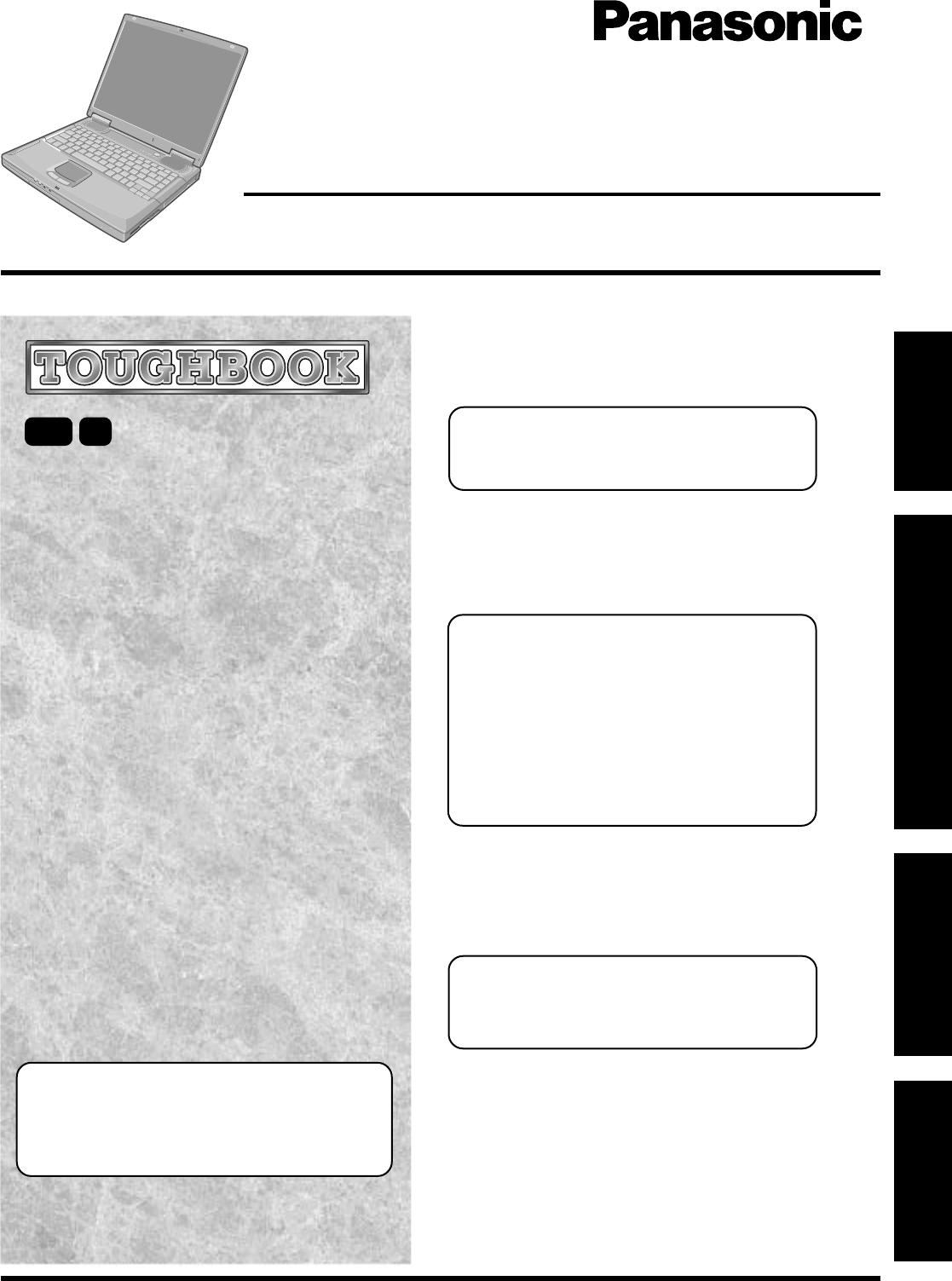
OPERATING INSTRUCTIONS
Personal Computer
®
Appendix
LIMITED USE LICENSE AGREEMENT.........26
Hard Disk Data Erase Utility...........................28
Easy CD Creator™ 5 .....................................29
WinDVD™ ......................................................31
Names and Functions of Parts .......................33
Specifications .................................................35
LIMITED WARRANTY ....................................37
Troubleshooting
List of Error Codes .........................................19
Dealing with Problems (Summary).................21
Reinstalling Software .....................................24
Operation
Starting Up/Shutting Down ............................ 14
Touch Pad ..................................................... 17
Reference Manual ......................................... 18
Getting Started
Read Me First.................................................. 3
First-time Operation ........................................ 9
Contents
[Additional Manual]
Reference Manual
This manual can be accessed on your computer.
Refer to page 18 on how to access the Reference Manual.
Reference Manual
•Read Me First
•Key Combinations
Reference Manual
•Touch Pad (Advanced)
•Standby/Hibernation
Functions
•Security Measures
•Computing on the
Road
•Battery Power
•CD Drive
•PC Cards
•RAM Module
•Port Replicator
•Printer
•External Display
•USB Devices
•IEEE 1394 Devices
•Modem
•LAN
•Hard Disk Drive
•Setup Utility
•LED Indicators
Reference Manual
•Technical Information
•DMI Viewer •List of Error Codes
•Dealing with Problems
(Advanced)
Appendix Getting StartedOperationTroubleshooting
Model No. CF-50 Series
2000
Please read these instructions carefully before using this product and save this manual for future use.
XP
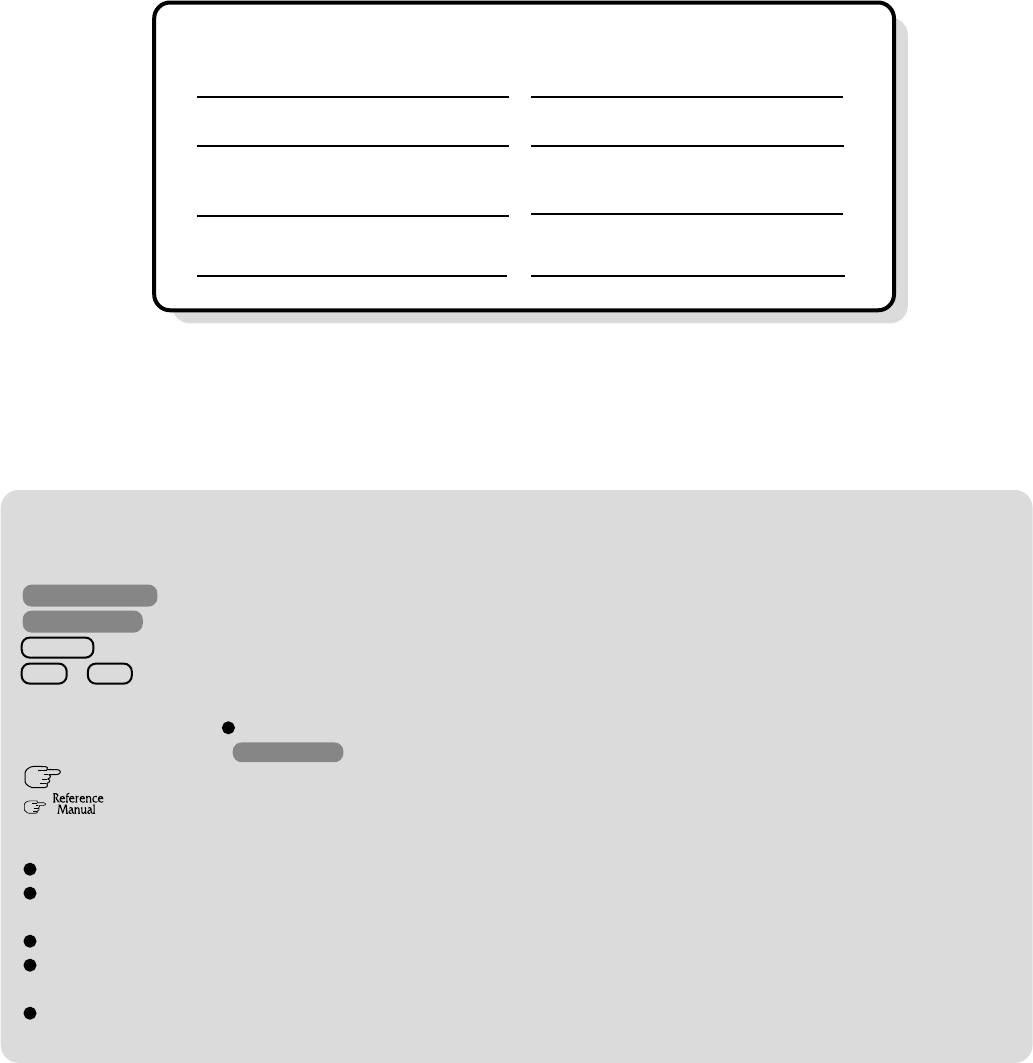
2
Introduction
Thank you for purchasing the Panasonic computer. Read the operating instructions thoroughly for proper operation of your new
computer.
Illustrations and Terminology in this Manual
Copyright
This manual is copyrighted by Matsushita Electric Industrial Co., Ltd. with all rights reserved. No part of this manual may be
reproduced in any form without the prior written permission of Matsushita Electric Industrial Co., Ltd.
No patent liability is assumed with respect to the use of the information contained herein.
©2002 Matsushita Electric Industrial Co., Ltd. All Rights Reserved.
Disclaimer
Computer specifications and manuals are subject to change without notice. Matsushita Electric Industrial Co., Ltd. assumes no
liability for damage incurred directly or indirectly from errors, omissions or discrepancies between the computer and the manuals.
Trademarks
Microsoft, Windows and the Windows logo are registered trademarks of Microsoft Corporation of the United States and/or other
countries.
PS/2® is a registered trademark of International Business Machines Corporation.
Intel, Pentium and SpeedStep are either registered trademarks or trademarks of Intel Corporation.
Adobe® and Acrobat® are either registered trademarks or trademarks of Adobe Systems Incorporated in the United States and/or
other countries.
Roxio, the Roxio logo, Easy CD Creator and DirectCD are trademarks of Roxio, Inc. which may be registered in some jurisdictions.
WinDVD™ is a trademark of InterVideo, Inc.
Panasonic is a registered trademark of Matsushita Electric Industrial Co., Ltd.
* For the Model No., insert the 12 digit number (for example, CF-50Y5KNUDM) located on the
bottom of the computer.
NOTE:NOTE provides a useful fact or helpful information.
CAUTION:CAUTION indicates a condition that may result in minor or moderate injury.
WARNING:WARNING indicates a hazard that may result in moderate or serious injury.
Windows 2000 : Information for Microsoft® Windows® 2000 Professional users.
Windows XP : Information for Microsoft® Windows® XP Professional users.
Enter : This illustration means to press the [Enter] key.
Fn + F5 : This illustration means to press and hold the [Fn] key, then press the [F5] key.
[Start]* - [Run]: This illustration means to click [Start]*, then to click [Run].
For some applications, you may need to double-click.
* Windows XP : [start]
: Where to go for referred information.
: This illustration means to refer to the Reference Manual, which is available on your computer.
Refer to page 18 on how to access this manual.
Windows 2000 screens are used in this manual when no specific OS notes are required.
Some of the illustrations in this manual may differ slightly in shape from the actual items in order to make the explanation
easier to understand.
Circular media such as CD-ROM and DVD-ROM are described as “discs”.
The following drives are described as “CD drive”.
CD-ROM drive, DVD-ROM drive, CD-R/RW drive, DVD-ROM & CD-R/RW drive.
If the user has logged on without the administrator authority, some functions may not be executable, and some screens may
not be displayed as shown in this manual. If this happens, log on with the administrator authority to enable these functions.
Customer's Record
Serial No.
or
Date of Purchase
Model No.*
Code No.
Dealer's Name
Dealer's Address
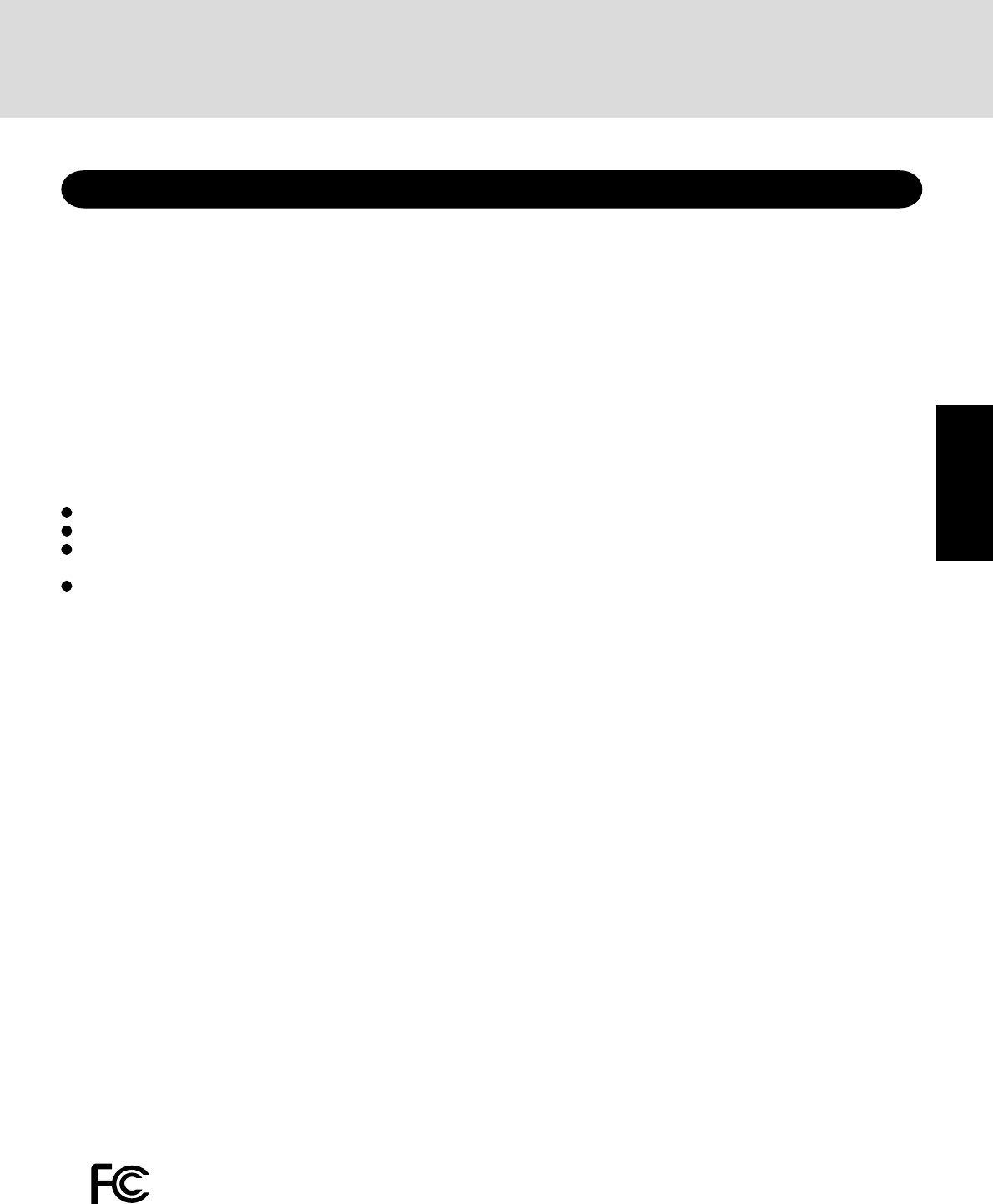
3
Getting Started
Federal Communications Commission Radio
Frequency Interference Statement
Note: This equipment has been tested and found to comply with
the limits for a Class B digital device, pursuant to Part 15 of the
FCC Rules. These limits are designed to provide reasonable
protection against harmful interference in a residential
installation. This equipment generates, uses and can radiate
radio frequency energy and, if not installed and used in
accordance with the instructions, may cause harmful interference
to radio communications. However, there is no guarantee that
interference will not occur in a particular installation. If this
equipment does cause harmful interference to radio or television
reception, which can be determined by turning the equipment
off and on, the user is encouraged to try to correct the interference
by one or more of the following measures:
Reorient or relocate the receiving antenna.
Increase the separation between the equipment and receiver.
Connect the equipment into an outlet on a circuit different
from that to which the receiver is connected.
Consult the Panasonic Service Center or an experienced ra-
dio/TV technician for help.
Warning
To assure continued compliance, use only shielded interface
cables when connecting to a computer or peripheral. Also, any
changes or modifications not expressly approved by the party
responsible for compliance could void the user’s authority to
operate this equipment.
FCC RF Exposure Warning: This computer is provided with
PC Card slots that could be used with wireless transmitter(s),
which will be specifically recommended, when they become
available. Other third-party wireless transmitter(s) have not been
RF exposure evaluated for use with this computer and may not
comply with FCC RF exposure requirements.
This device complies with Part 15 of the FCC Rules. Operation
is subject to the following two conditions:
(1) This device may not cause harmful interference, and
(2) This device must accept any interference received, including
interference that may cause undesired operation.
Responsible Party: Matsushita Electric Corporation of America
One Panasonic Way
Secaucus, NJ 07094
Tel No:1-800-LAPTOP-5 (1-800-527-8675)
For U.S.A.
2. An FCC compliant telephone cord and modular plug is pro-
vided with this equipment. This equipment is designed to be
connected to the telephone network or premises wiring using
a compatible modular jack which is Part 68 compliant. See
Installation Instructions for details.
3. The REN is used to determine the quantity of devices which
may be connected to the telephone line. Excessive RENs on the
telephone line may result in the devices not ringing in response
to an incoming call. In most, but not all area, the sum of RENs
should not exceed five (5.0). To be certain of the number of
devices that may be connected to a line, as determined by the
total RENs, contact the local telephone company.
4. If your telephone equipment cause harm to the telephone net-
work, the telephone company will notify you in advice that
temporary discontinuance of service may be required. But if
advice notice isn’t practical, the telephone company will no-
tify the customer as soon as possible. Also, you will be ad-
vised of your right to file a complaint with the FCC if you
believe it is necessary.
5. The telephone company may take changes in it’s facilities,
equipment, operations or procedures that could affect the op-
eration of the equipment. If this happens the telephone com-
pany will provide advance notice in order for you to make
necessary modifications to maintain uninterrupted service.
6. If trouble is experienced with this equipment, for repair or
warranty information, please contact Matsushita Electric
Corporation of America at DIAL TOLL FREE 1-800-
LAPTOP5 (1-800-527-8675). If the equipment is causing harm
to the telephone network, the telephone company may request
that you disconnect the equipment until the problem is resolved.
7. There are no user serviceable parts contained in this equipment.
8. This equipment may not be used on coin service provided by
the telephone company. Connection to party lines is subject to
state tariffs.
9. The Telephone Consumer Protection Act of 1991 makes it
unlawful for any person to use a computer or other electronic
device to send any message via a telephone fax machine un-
less such message clearly contains in a margin at the top or
bottom of each transmitted page or on the first page of the
transmission, the date and time it is sent and an identification
of the business or other entry, or other individual sending the
message and the telephone number of the sending machine or
such business, other entity, or individual. In order to program
this information into your fax software, you should refer to
the manual of the Fax software being used.
10.According to the FCC’s electrical safety advisory, we recom-
mend that you may install an AC surge arrestor in the AC outlet
to which this equipment is connected. Telephone companies re-
port that electrical surges, typically lightning transients, are very
destructive to customer terminal equipment connected to AC
power sources and that this is a major nationwide problem.
“Caution: To reduce the risk of fire, use only No.26 AWG or larger telecom-
munication line cord.”
“ATTENTION: Pour réduire le risque d’incendie, utiliser uniquement des
conducteurs de télécommunications 26 AWG ou de section supérieure.”
Notice for the products using LCD
This product uses one or more fluorescent lamps containing a
small amount of mercury. It also contains lead in some compo-
nents. Disposal of these materials may be regulated in your com-
munity due to environmental considerations. For disposal or re-
cycling information please contact your local authorities, or the
Electronics Industries Alliance: <http://www.eiae.org.>
Read Me First
FCC Regulation Notice for modem
This equipment contains a FCC approved modem.
Manufacturer of modem: AMBIT Microsystems Corporation
Model No. T60M099.03 or J07M040.07
FOR HOME OR OFFICE USE
Tested To Comply
With FCC Standards
1. This equipment complies with Part 68 of the FCC rules. On
the computer is a label that contains, among other informa-
tion, the FCC registration number and ringer equivalence
number (REN) for this equipment. If required, this informa-
tion must be provided to the telephone company.

4
Getting Started
For Canada
Industry Canada (IC) Notice for modem
This equipment contains an Industry Canada approved modem unit.
The Industry Canada label is affixed on the modem unit.
EQUIPMENT ATTACHMENT LIMITATIONS
“NOTICE: The Industry Canada label identifies certified
equipment. This certification means that the equipment meets
telecommunications network protective, operational and
safety requirements as prescribed in the appropriate Terminal
Equipment Technical Requirements document(s). The
Department does not guarantee the equipment will operate
to the user’s satisfaction.
Before installing this equipment, users should ensure that it
is permissible to be connected to the facilities of the local
telecommunications company. The equipment must also be
installed using an acceptable method of connection. The
customer should be aware that compliance with the above
conditions may not prevent degradation of service in some
situations.
Repairs to certified equipment should be coordinated by a
representative designated by the supplier. Any repairs or
alterations made by the user to this equipment, or equipment
malfunctions, may give the telecommunications company
cause to request the user to disconnect the equipment.
Users should ensure for their own protection that the
electrical ground connections of the power utility, telephone
lines and internal metallic water pipe system, if present, are
connected together. This precaution may be particularly
important in rural areas. Caution: Users should not attempt
to make such connections themselves, but should contact
the appropriate electric inspection authority, or electrician,
as appropriate.”
“NOTICE: The Ringer Equivalence Number (REN) assigned
to each terminal device provides an indication of the
maximum number of terminals allowed to be connected to a
telephone interface. The termination on an interface may
consist of any combination of devices subject only to the
requirement that the sum of the Ringer Equivalence Numbers
of all the devices does not exceed 5.”
REN: See bottom of the computer
RESTRICTIONS CONCERNANT LE RACCORDEMENT
DE MATÉRIEL
“AVIS: L’étiquette d’Industrie Canada identifie le matériel
homologué. Cette étiquette certifie que le matériel est
conforme aux normes de protection, d’exploitation et de
sécurité des réseaux de télécommunications, comme le
prescrivent les documents concernant les exigences
techniques relatives au matériel terminal. Le Ministère
n’assure toutefois pas que le matériel fonctionnera à la
satisfaction de l’utilisateur.
Avant d’installer ce matériel, l’utilisateur doit s’assurer qu’il
est permis de le raccorder aux installations de l’entreprise
locale de télécommunication. Le matériel doit également être
installé en suivant une méthode acceptée de raccordement.
L’abonné ne doit pas oublier qu’il est possible que la
conformité aux conditions énoncées ci-dessus n’empêche
pas la dégradation du service dans certaines situations.
Les réparations de matériel homologué doivent être
coordonnées par un représentant désigné par le fournisseur.
L’entreprise de télécommunications peut demander à
l’utilisateur de débrancher un appareil à la suite de
réparations ou de modifications effectuées par l’utilisateur
ou à cause de mauvais fonctionnement.
Pour sa propre protection, l’utilisateur doit s’assurer que tous
les fils de mise à la terre de la source d’énergie électrique,
des lignes téléphoniques et des canalisations d’eau
métalliques, s’il y en a, sont raccordés ensemble. Cette
précaution est particulièrement importante dans les régions
rurales. Avertissement: L’utilisateur ne doit pas tenter de faire
ces raccordements lui-même; il doit avoir recours à un service
d’inspection des installations électriques, ou à un électricien,
selon le cas.”
“AVIS: L’indice d’équivalence de la sonnerie (IES) assigné
à chaque dispositif terminal indique le nombre maximal de
terminaux qui peuvent être raccordés à une interface. La
terminaison d’une interface téléphonique peut consister en
une combinaison de quelques dispositifs, à la seule condition
que la somme d’indices d’équivalence de la sonnerie de touts
les dispositifs n’excède pas 5.”
IES: Voir sous le fond de l’ordinateur
Important Safety Instructions / Importantes Mesures De Sécurité
When using your telephone equipment, basic safety pre-
cautions should always be followed to reduce the risk of
fire, electric shock and injury to persons, including the fol-
lowing:
1.Do not use this product near water, for example, near a
bath tub, wash bowl, kitchen sink or laundry tub, in a wet
basement or near a swimming pool.
2.Avoid using a telephone (other than a cordless type) dur-
ing an electrical storm. There may be a remote risk of
electric shock from lightning.
3.Do not use the telephone to report a gas leak in the vicin-
ity of the leak.
4.Use only the power cord and batteries indicated in this
manual. Do not dispose of batteries in a fire. They may
explode. Check with local codes for possible special dis-
posal instructions.
SAVE THESE INSTRUCTIONS
Certaines mesures de sécurité doivent être prises pendant
l’utilisation de matérial téléphonique afin de réduire les
risques d’incendie, de choc électrique et de blessures. En
voici quelquesunes:
1.Ne pas utiliser l’appareil près de l’eau, p.ex., près d’une
baignoire, d’un lavabo, d’un évier de cuisine, d’un bac à
laver, dans un sous-sol humide ou près d’une piscine.
2.Éviter d’utiliser le téléphone (sauf s’il s’agit d’un appareil
sans fil) pendant un orage électrique. Ceci peut présenter
un risque de choc électrique causé par la foudre.
3.Ne pas utiliser l’appareil téléphonique pour signaler une
fuite de gaz s’il est situé près de la fuite.
4.Utiliser seulement le cordon d’alimentation et le type de
piles indiqués dans ce manual. Ne pas jeter les piles dans
le feu: elles peuvent exploser. Se conformer aux règlements
pertinents quant à l’élimination des piles.
CONSERVER CES INSTRUCTIONS
Read Me First
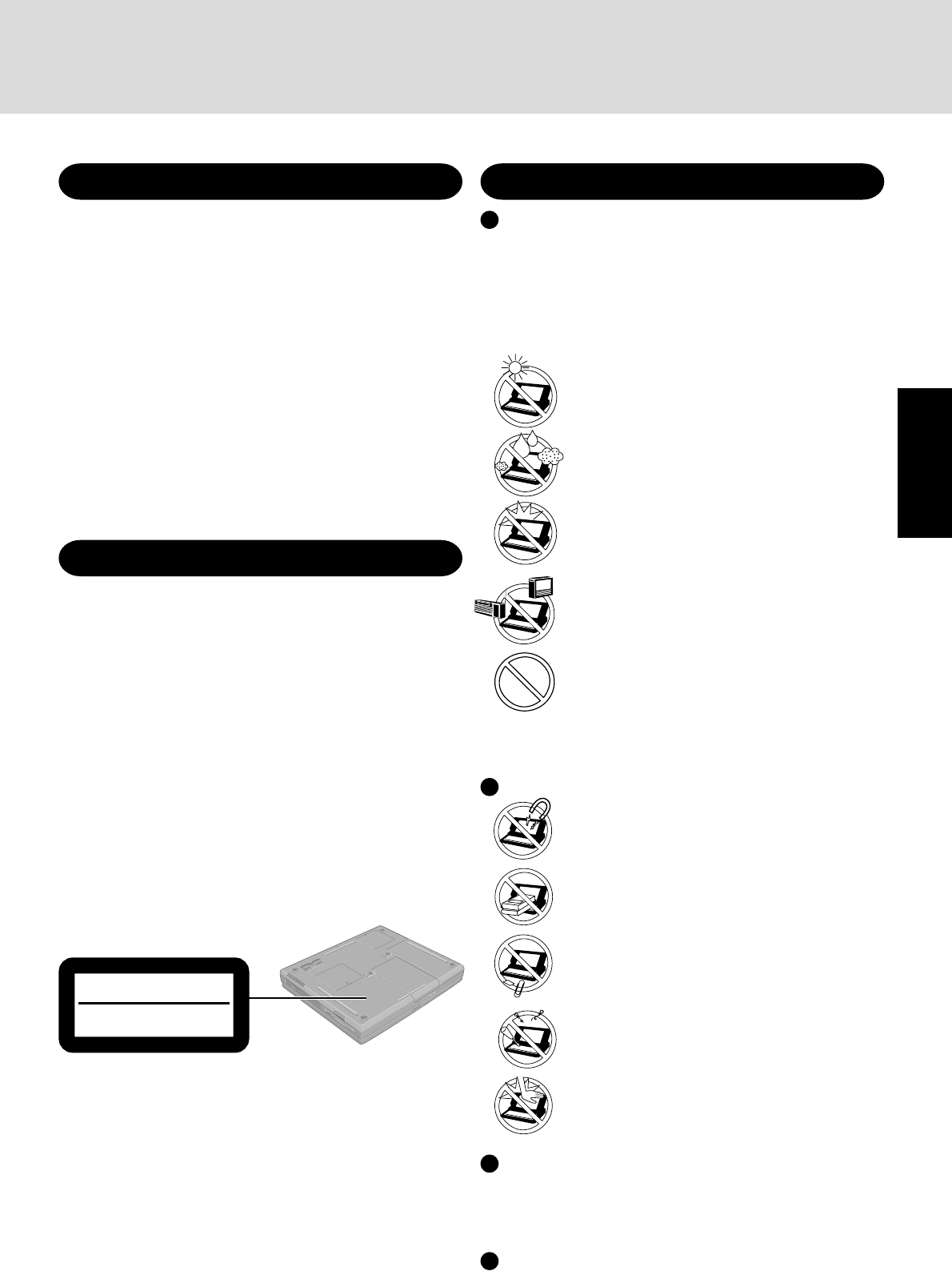
5
Getting Started
Avoid Extreme Heat and Cold
Do not store or use the computer in locations
exposed to heat, direct sunlight, or extreme cold.
Avoid moving the computer between locations with
large temperature difference.
Operation: 5 oC to 35 oC {41 oF to 95 oF}
Storage: -20 oC to 60 oC {-4 oF to 140 oF}
Avoid Direct Sunlight on the LCD Panel
The LCD panel should not be exposed to direct
sunlight or ultraviolet light.
Avoid Humidity, Liquids and Dust
Do not store or use the computer in locations exposed
to high humidity, liquids (including rain) or dust.
Prevent Shock
Avoid subjecting the computer to severe vibrations
or impact. Do not place the computer inside a car
trunk.
Avoid Radio Frequency Interference
Do not place the computer near a television or ra-
dio receiver.
Avoiding low-temperature burns
Avoid more than casual contact with any heat pro-
ducing area of the notebook computer, AC adap-
tor, and any option or accessory you use with it.
Even low heat, if warmer than body temperature,
can cause a burn, if the skin is exposed to the heat
source for a long enough period of time.
Usage
Lithium Battery!
This computer contains a lithium battery to enable the date, time,
and other data to be stored. The battery should only be exchanged
by authorized service personnel.
Warning! A risk of explosion from incorrect installation or mis-
application may possibly occur.
Pile au lithium!
Le micro-ordinateur renferme une pile au lithium qui permet de
sauvegarder certaines données comme la date et l’heure
notamment. Elle ne devra être remplacée que par un technicien
qualifié.
Avertissement! Risque d’explosion en cas de non respect de cette
mise en garde!
Lithium Battery
CD Drive Caution
CAUTION!
THIS PRODUCT UTILIZES A LASER.
USE OF CONTROLS, ADJUSTMENTS OR PERFORMANCE OF
PROCEDURES OTHER THAN THOSE SPECIFIED HEREIN MAY
RESULT IN HAZARDOUS RADIATION EXPOSURE.
DO NOT OPEN COVERS AND DO NOT REPAIR YOURSELF.
REFER SERVICING TO QUALIFIED PERSONNEL
AVERTISSEMENT!
CET APPAREIL UTILISE UN LASER.
L’UTILISATION DE COMMANDES OU DE RÉGLAGES OU
L’EXÉCUTION DE PROCÉDURES AUTRES QUE CELLES
SPÉCIFIÉES ICI PEUVENT PROVOQUER UNE EXPOSITION À
DES RADIATIONS DANGEREUSES.
NE PAS OUVRIR LES COUVERCLES NI ESSAYER DE RÉPARER
SOI-MÊME.
CONFIER TOUT TRAVAIL D'ENTRETIEN À UN PERSONNEL
QUALIFIÉ.
Bottom
Precautions
Handling
Avoid Magnetic Fields
Keep the computer away from magnets.
Data stored on the hard disk may be lost.
Avoid Stacking
Do not place heavy objects on top of the computer.
Keep Small Objects Away
Do not insert paper clips or other small objects into
the computer.
Do Not Disassemble the Computer
Do not attempt to disassemble your computer.
Avoid Excessive Force on the Display
Do not apply excessive downward force on the display
when it is completely opened, especially when plugs
and/or cables are connected to the rear of the computer.
Peripherals
Incorrectly using peripheral devices may lead to a decrease in
performance, an increase in temperature and/or damage your
computer. For more information on peripheral devices, refer to
the Reference Manual.
Cables
Use of an interface cable longer than 3 m (9.84 feet) is not rec-
ommended.
CLASS 1 LASER PRODUCT
LASER KLASSE1
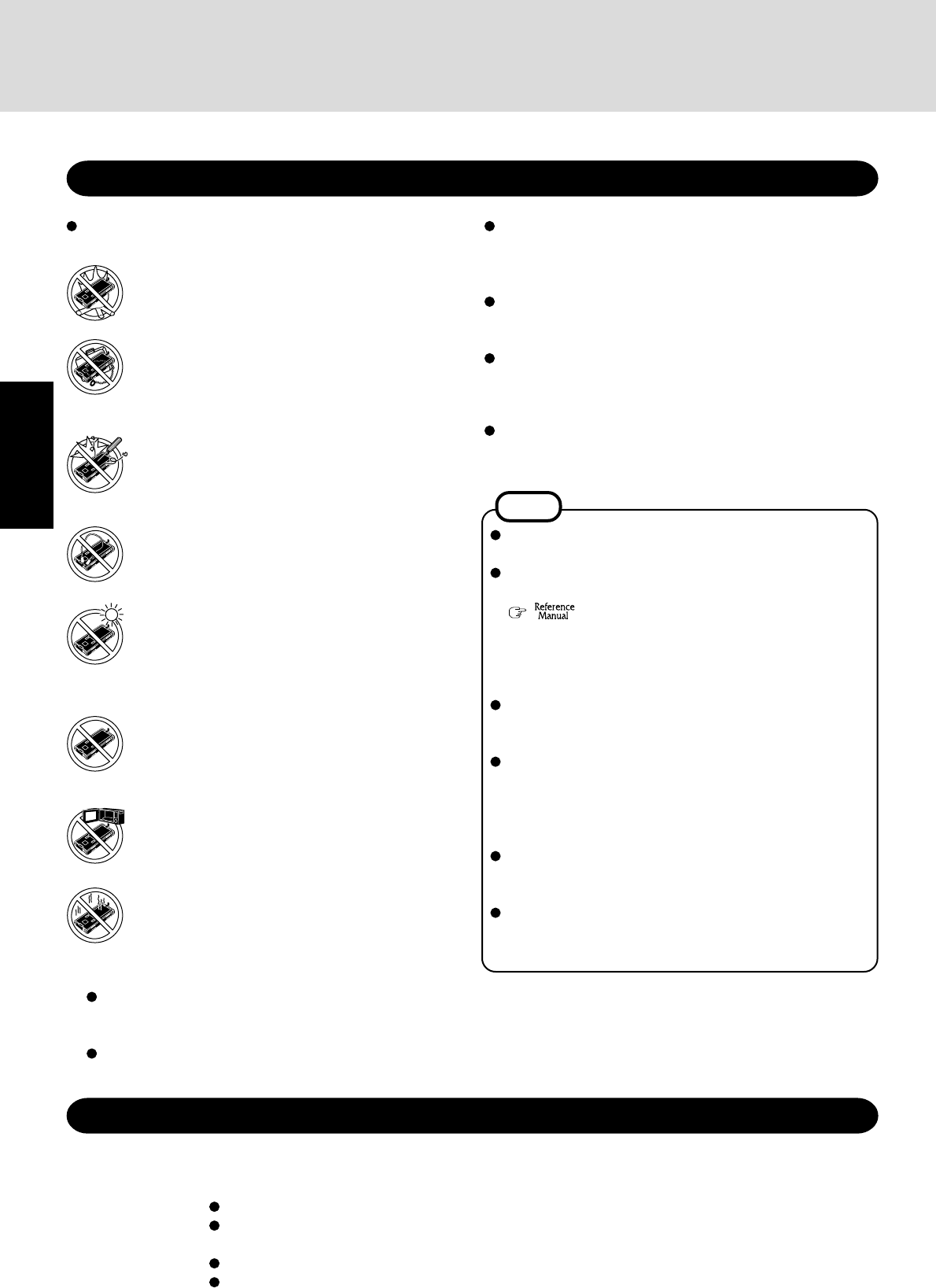
6
Getting Started
Care should be exercised with regard to the following in or-
der to avoid the possibility of overheating, fire or damage.
Avoid Heat
Do not throw the battery pack into a fire or ex-
pose it to excessive heat.
Keep Articles Away
Do not place the battery pack together with articles
such as necklaces or hairpins when carrying or stor-
ing.
Do Not Disassemble
Do not insert sharp objects into the battery pack,
expose it to bumps or shocks, deform, disassemble,
or modify it.
Do Not Short
Do not short the positive (+) and negative (-) con-
tacts.
Avoid Extreme Heat, Cold and Direct Sunlight
Do not charge, use or leave the battery pack for ex-
tended periods where it will be exposed to direct
sunlight, in a hot place (in a car on a sunny day, for
example), or in a cold place.
Do Not Use With Any Other Computer
The battery pack is rechargeable and was intended for
the specified computer. Do not use it with a computer
other than the one for which it was designed.
Do Not Put into a Microwave
Do not put the battery pack into a microwave oven
or a pressurized chamber.
Stop Using
Should the battery emit an abnormal odor, become
hot to the touch, become discolored, change shape,
or become in any way different from normal, re-
move it from the computer and stop using it.
Precautions (Battery Pack)
NOTE
The battery pack may become warm during recharging or
normal use. This is completely normal.
Recharging will not commence outside of the allowable
temperature range (0 °C to 50 °C {32°F to 122 °F})
“Battery Power”. Once the allowable range
requirement is satisfied, charging begins automatically.
Note that the recharging time varies based on the usage
conditions. (Recharging takes longer than usual when the
temperature is 10 °C {50 °F} or less.)
If the temperature is low, the operating time is shortened.
Only use the computer within the allowable temperature
range.
The battery pack is a consumable item. If the amount of
time the computer can be run off a particular battery pack
becomes dramatically shorter and repeated recharging does
not restore its performance, the battery pack should be
replaced with a new one.
When transporting a spare battery inside a package, brief-
case, etc., it is recommended that it be placed in a plastic
bag so that its contacts are protected.
Always power off the computer when it is not in use. Leav-
ing the computer on when the AC adaptor is not connected
will exhaust the remaining battery capacity.
Do not touch the terminals on the battery pack. The bat-
tery pack may no longer function properly if the contacts
are dirty or damaged.
Do not expose the battery pack to water, or allow it to
become wet.
If the battery pack will not be used for a long period of time
(a month or more), charge or discharge (use) the battery pack
until the remaining battery level becomes 30% to 40% and
store it in a cool, dry place.
This computer prevents overcharging of the battery by re-
charging only when the remaining power is less than approx.
95% of capacity.
The battery pack is not charged when the computer is first
purchased. Be sure to charge it before using it for the first
time. When the AC adaptor is connected to the computer,
charging begins automatically.
Should the battery leak and the fluid get into your eyes, do not
rub your eyes. Immediately flush your eyes with clear water
and see a doctor for medical treatment as soon as possible.
Read Me First
When Using Peripheral Devices
Pay strict attention to the following points to avoid damage to the computer, peripheral devices, cables, etc.
Also, in addition to following this manual, carefully read the instruction manuals for the peripheral devices
being used.
Connect the devices properly, paying close attention to the condition and position of the connectors.
If a connection cannot be made easily, do not apply undue force; check once more to confirm the condi-
tion and position of the connector (alignment of pins, etc.) .
If the connector has holding screws, fasten the screws firmly.
Do not carry the computer with cables attached, and do not pull on the cables forcefully.
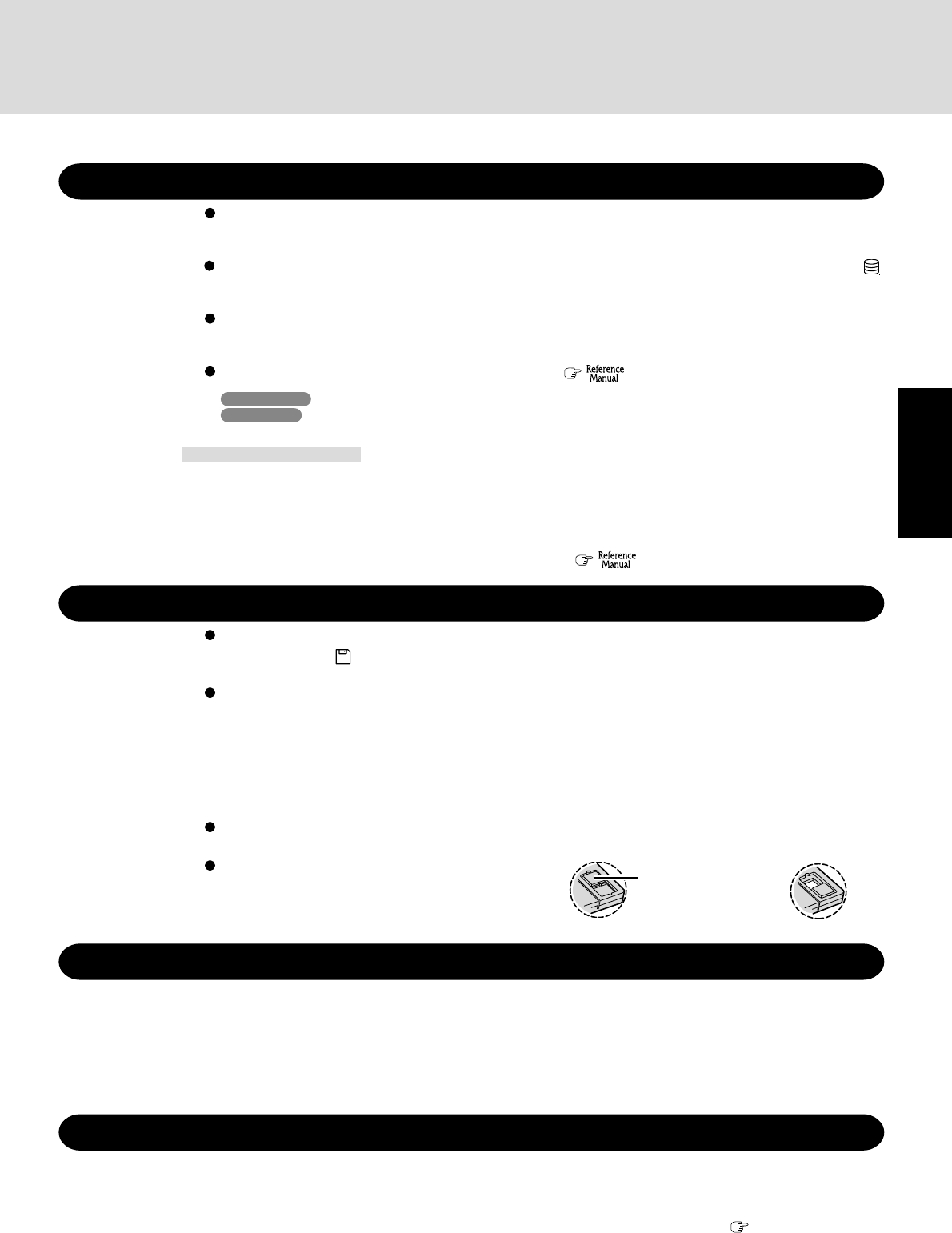
7
Getting Started
Do not power down your computer or press the floppy disk drive eject button while the floppy disk
drive indicator ( ) is on.
Doing so may damage the data on the floppy disk and render the floppy disk useless.
Use care when handling floppy disks.
To protect the data on your floppy disks or to prevent a floppy disk from becoming stuck in your com-
puter, avoid the following:
• Sliding the shutter on the floppy disk manually.
• Exposing the floppy disk to a magnetic field.
• Storing the floppy disk in locations prone to high temperatures, low pitched noise, dampness, or dust.
• Applying more than one label on the floppy disk.
Confirm the contents of a floppy disk before formatting it.
Confirm that no important data is on the floppy disk, because all data on the floppy disk will be erased.
Use the write-protect tab.
This is a must for preserving important data.
This prevents your data from being erased or over-
written.
Saving Data on the Hard Disk
Write Enable Write Disable
Write-protect Tab
Saving Data on Floppy Disks
Users are advised to purchase the latest versions of virus protection software and use them regularly.
We recommend you run the software:
• When booting your computer.
• After receiving data.
We recommend that you check data received on disks or from external sources, such as data downloaded
from the Internet, e-mail, etc. (For compressed files, uncompress them before running a check).
Computer Viruses
Do not expose your computer to shock.
Use care when handling your computer, shock may damage your hard disk or make your software appli-
cations and data unusable.
Do not power down your computer while software applications are running or hard disk drive indicator ( )
is on.
Properly shut Windows* down to avoid problems.
Save all valuable data to disks.
Backing up data to disks will limit damage should trouble occur to your computer or should you inad-
vertently change or erase data.
Use the security function for all important data. ( “Security Measures”)
*Windows 2000 : This computer uses Microsoft® Windows® 2000 Professional.
Windows XP : This computer uses Microsoft® Windows® XP Professional.
Hard Disk Lock
When the Hard Disk Lock is set to [Enable], it is impossible to read/write data from/to the hard disk when the
hard disk is installed in a different computer, since a password is also set for the hard disk. When the hard disk
is returned to the original computer, you can read/write data as before. In this case, however, make the settings
in the Setup Utility exactly the same as they were before the hard disk was removed. (Note that this Hard Disk
Lock does not guarantee the complete protection of data.) ( “Security Measures”)
When Disposing of or Transferring Ownership of This Device
When disposing of or transferring ownership of this device, completely erase all data on the hard disk in order
to prevent the theft of hard disk data. Even if you delete data or initialize the hard disk through normal Win-
dows commands, data can still be read using special software. In order to erase all data, either have the data
erased by a specialist (at a charge) or use the hard disk data erase utility (included) ( Page 28). (Note that
this hard disk data erase utility does not guarantee that data will be completely erased.)
Also note that transferring ownership of this device without deleting software from the hard disk may
violate software user’s licenses.

8
Getting Started
Read Me First
Environment
Place the computer on a flat stable surface.
In use: Temperature: 5 °C to 35 °C {41 °F to 95 °F}
Humidity: 30% to 80% RH (No condensation)
Not in use: Temperature: -20 °C to 60 °C {-4 °F to 140 °F}
Humidity: 30% to 90% RH (No condensation)
Usage Environment
Such areas may result in damage to the computer.
Areas with electronic equipment
These areas may interfere with your display or cause your computer to produce strange
sounds.
Areas with extremely high/low temperatures
Do not leave things near the computer that are sensitive to heat. During operation, the
computer may become warm.
Places not to use your computer
Handling
This computer has been designed so as to minimize shock to the LCD and hard disk drive,
etc., but no warranty is provided against such trouble. Therefore, as a precision instrument,
be extremely careful in the handling.
Do not drop or hit your computer against solid objects.
Do not carry your computer when it is on.
Remove all external devices, cables, and PC Cards sticking out of the computer (see the
figure on the left) before transporting the computer.
We recommend preparing a fully charged battery.
When transporting a spare battery inside a package, briefcase, etc., it is recommended that it
be placed in a plastic bag so that its contacts are protected.
Do not place the computer upright or allow it to tip over. When the computer receives
extremely strong shock after falling, the hard disk or floppy disk drive, etc., may become
inoperable.
Do not carry the computer while the display is open, or carry it by gripping the display.
Do not put anything (e.g., a piece of paper) between the display and keyboard.
Always carry your computer with you. Never check it in with luggage. For use of the com-
puter inside an aircraft, we recommend asking the airlines regarding their policy on this issue.
It is a good idea to make backup copies on disks and carry them with you.
Do not leave a disk in the drive while transporting your computer.
Maintenance
Areas excluding the display
Wipe these areas with a soft cloth, after applying water or detergent diluted with water to the
soft cloth and firmly wringing out excess water.
Display
Avoid using water when cleaning the panel. Ingredients included in water may leave scratches
and reduce readability of the screen.
<When cleaning dust/dirt>
Avoid rubbing off dust/dirt with cloth since it may leave scratch on the screen.
Sweep dust/dirt with fine brush, then wipe it with a dry soft cloth used for cleaning glasses.
<When cleaning oily surface>
Apply camera lens cleaner on a soft gauze and clean it with gentle force. Then, wipe with a
dry soft cloth used for cleaning glasses.
Touch Pad
page 17
Do not use benzene, thinner, or rubbing alcohol. Doing so may adversely affect the surface, e.g., discoloration.
In addition, do not use commercially-available household cleaners and cosmetics, as they may contain compo-
nents harmful to the surface.
Do not directly add or spray water or detergent. If liquid enters the inside of the computer, it may cause it to
work improperly or be damaged.
CAUTION
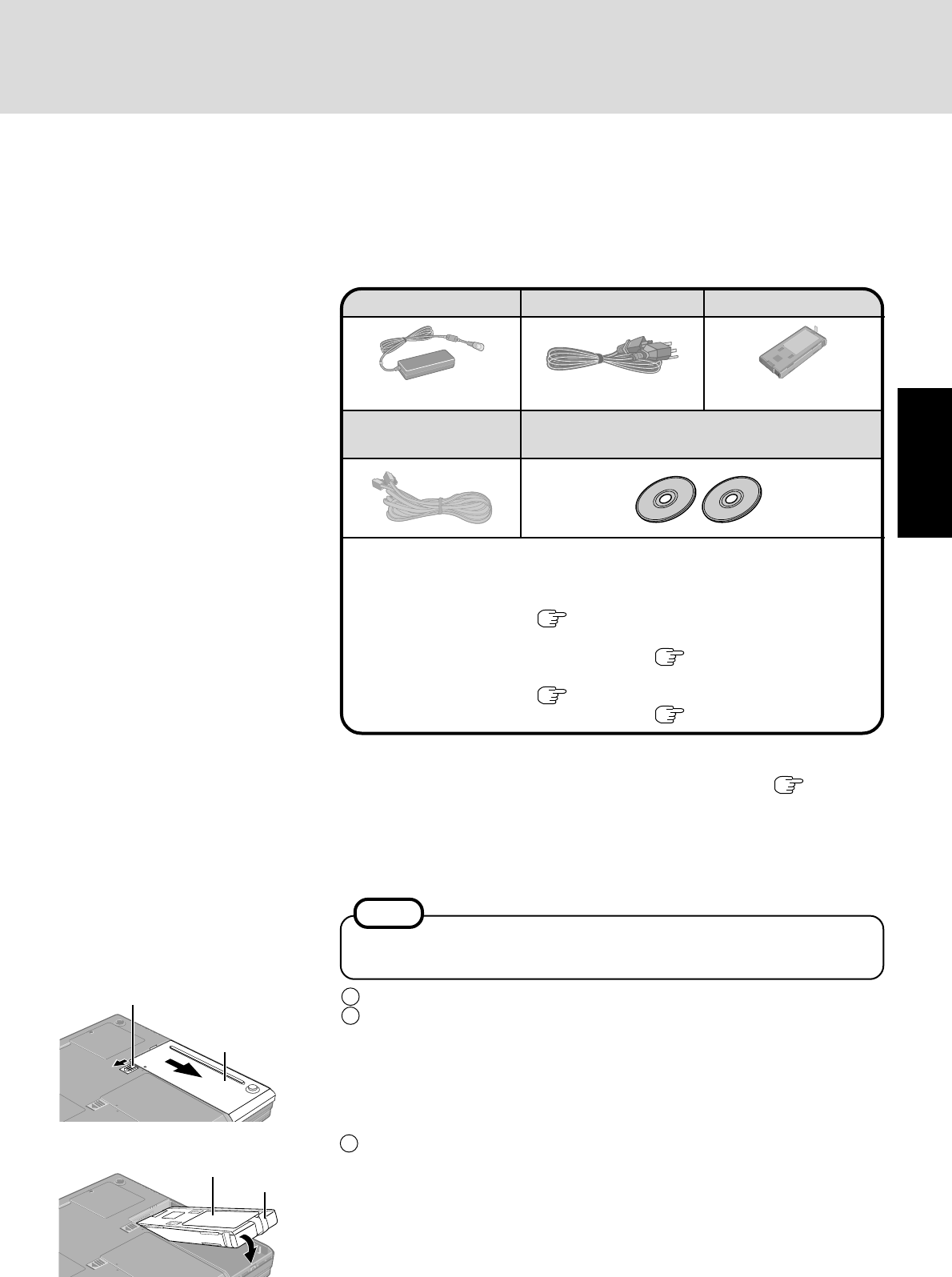
9
Getting Started
2Read the LIMITED USE LICENSE AGREEMENT ( page 26)
Before removing the seal covering the power switch, read the LIMITED USE LI-
CENSE AGREEMENT.
3Insert the battery pack
1Turn your computer over.
2Slide the latch, and then without releasing it, slide and remove the cover.
First-time Operation
Read the steps below to help you learn what parts are included, and to gain an understanding of
some basic computer-related operations.
1Confirm the inclusion of all parts
Make sure the parts shown in the figure have been supplied. If any of these items are
missing or is not working properly, contact Panasonic Technical Support.
Battery Pack
Cover
Tab
Model No : CF-AA1653AM
AC adaptor ..........1
Model No :CF-VZSU18A
AC Cord ...............1 Battery Pack........1
Modem Telephone
Cable ...................1 Product Recovery CD-ROM
Latch
Operating Instructions (This book)
...
1Windows® Book ......................... 1
<Model with a DVD-ROM Drive>
Win DVD™ CD-ROM ( Page 31)..................................................... 1
<Model with a CD-R/RW Drive>
Easy CD Creator™ 5 Basic CD-ROM ( Page 29).....................1
<Model with a DVD-ROM & CD-R/RW Drive>
Win DVD™ CD-ROM ( Page 31) ...............................................1
Easy CD Creator™ 5 Basic CD-ROM ( Page 29).....................1
3Put the battery pack into the computer and firmly attach the pack to the connector.
NOTE
Use only the specified battery pack (CF-VZSU18A, yellow tab) with your com-
puter. CF-VZSU18 (blue tab) cannot be used with this computer.
(To next page)
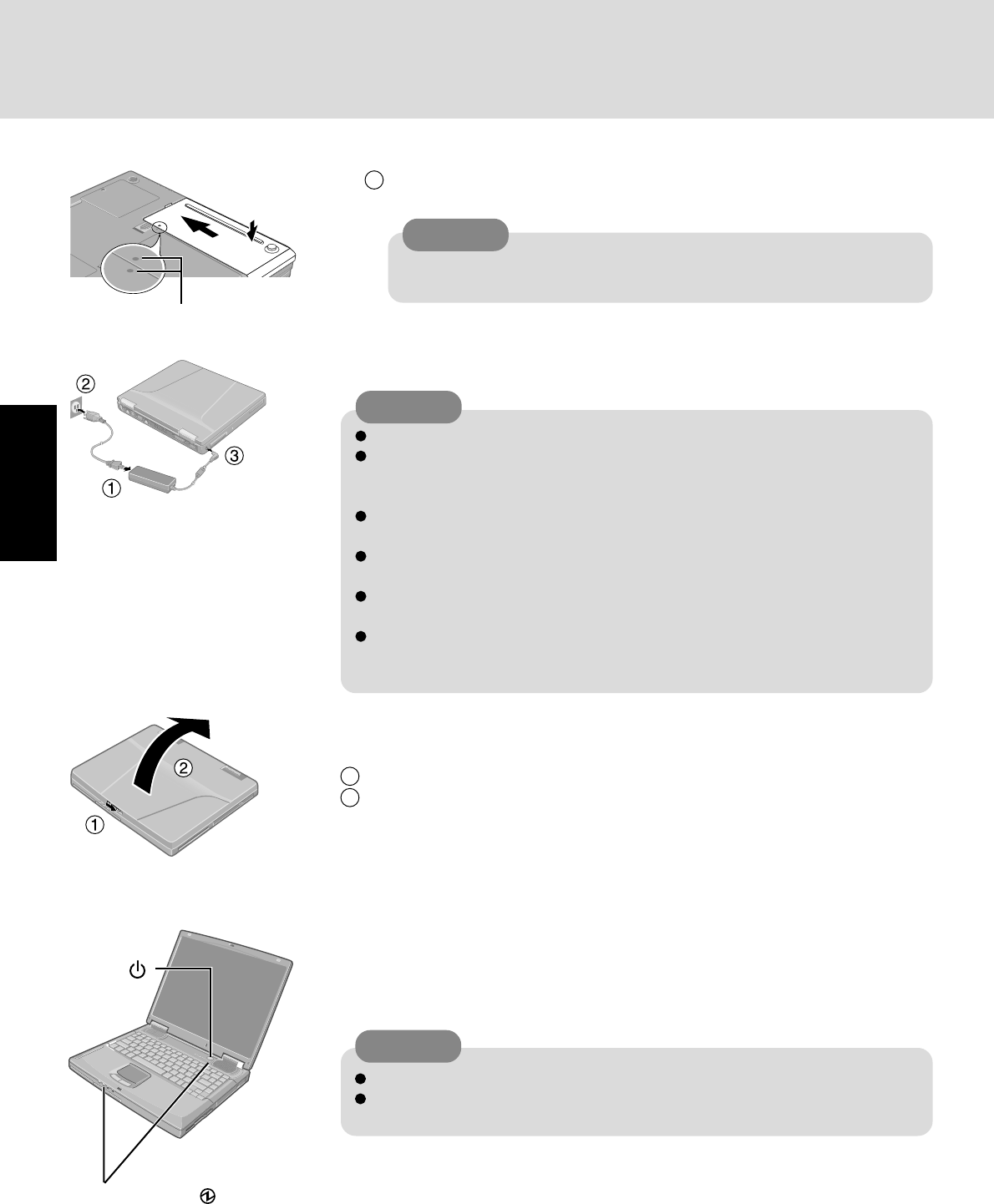
10
Getting Started
6Turn your computer on
Press the power switch and hold it for approximately one second until the power indicator
turns on before releasing it.
Do not press the power switch repeatedly.
Once the computer is powered off, you must wait at least ten seconds before pow-
ering it on again.
4Connect your computer to a power outlet
Be sure the AC adaptor is connected until completing Step 8 on page 12.
When using the computer for the first time, do not connect any peripheral device
except the battery pack and AC adaptor to the computer.
Handling the AC adaptor
Do not twist or pull the AC power cord forcefully. Doing so may damage the
connections.
Use only the specified AC adaptor with your computer. Using an AC adaptor other
than the one supplied might damage the battery and/or the computer.
When the DC plug is not connected to the computer, disconnect the AC cord from
your AC wall outlet.
Problems such as sudden voltage drops may arise during periods of thunder and
lightning. Since this could adversely affect your computer, an uninterruptible power
source (UPS) is highly recommended unless running from the battery pack alone.
5Open the display
1Slide the latch located at the front.
2Lift open the display.
First-time Operation
CAUTION
CAUTION
Power
Switch
Power Indicator
If the cover is not attached properly, the battery may fall out while the com-
puter is being carried.
CAUTION
4Match the mark on the cover to the body of the computer and slide the cover back
into place. Be sure the tab does not get caught when closing the cover.
Mark
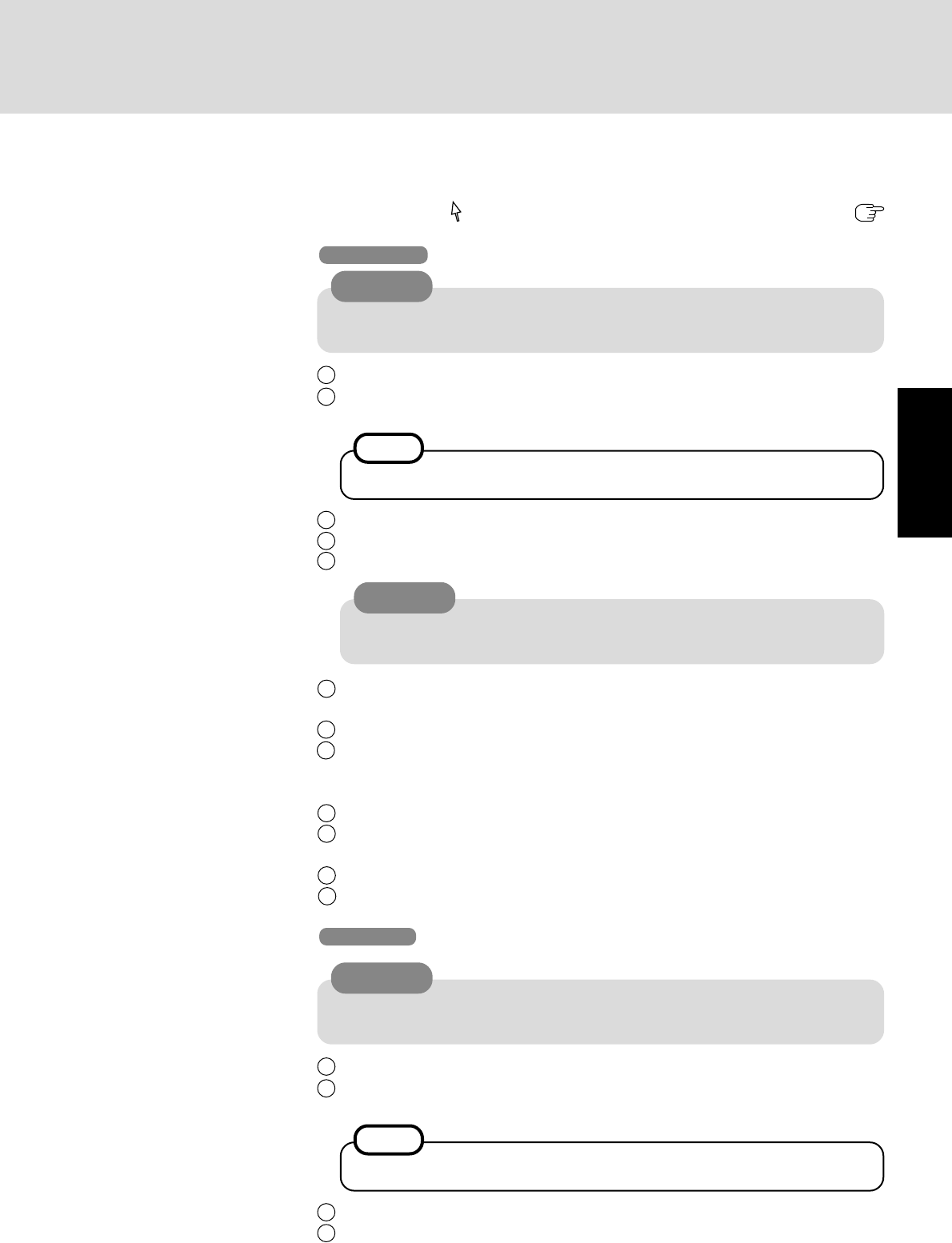
11
Getting Started
7Setup Windows
Moving the cursor ( ) or clicking buttons can be performed with the touch pad (
page 17).
1At the [Welcome to the Windows 2000 Setup Wizard], select [Next].
2After reading the agreement, select [I accept this agreement] or [I don’t accept this
agreement], then select [Next].
3Select settings for your region, then select [Next].
4Enter your name and organization and then select [Next].
5Enter your computer name and administrator password and then select [Next].
Windows 2000
NOTE
If [I don’t accept this agreement] is selected, the Windows setup will be aborted.
Do not press any key or move the touch pad until [Windows 2000 Professional Setup]
is displayed.
CAUTION
CAUTION
Remember this password! If the password is forgotten, Windows 2000 cannot be
operated.
6Enter the correct date, time and the time zone, then select [Next].
You can also complete these settings at a later time.
7At the [Networking Settings], select [Typical settings], then select [Next].
8At the [Workgroup or Computer Domain], select [No, this computer is not on a net-
work, or is on a network without a domain], then select [Next].
The computer will restart.
9At the [Welcome to the Network Identification Wizard], select [Next].
10
At the [Users of This Computer], select [Users must enter a user name and password to
use this computer], then select [Next].
11
Select [Finish].
12
Enter your administrator password and select [OK].
Windows XP
NOTE
If [I don’t accept this agreement] is selected, the Windows setup will be aborted.
Do not press any key or move the touch pad until [Windows XP Professional Setup] is
displayed.
CAUTION
1At the [Welcome to the Windows XP Setup Wizard], select [Next].
2After reading the agreement, select [I accept this agreement] or [I don’t accept this
agreement], then select [Next].
3Select settings for your region, then select [Next].
4Enter your name and organization and then select [Next].
(To next page)
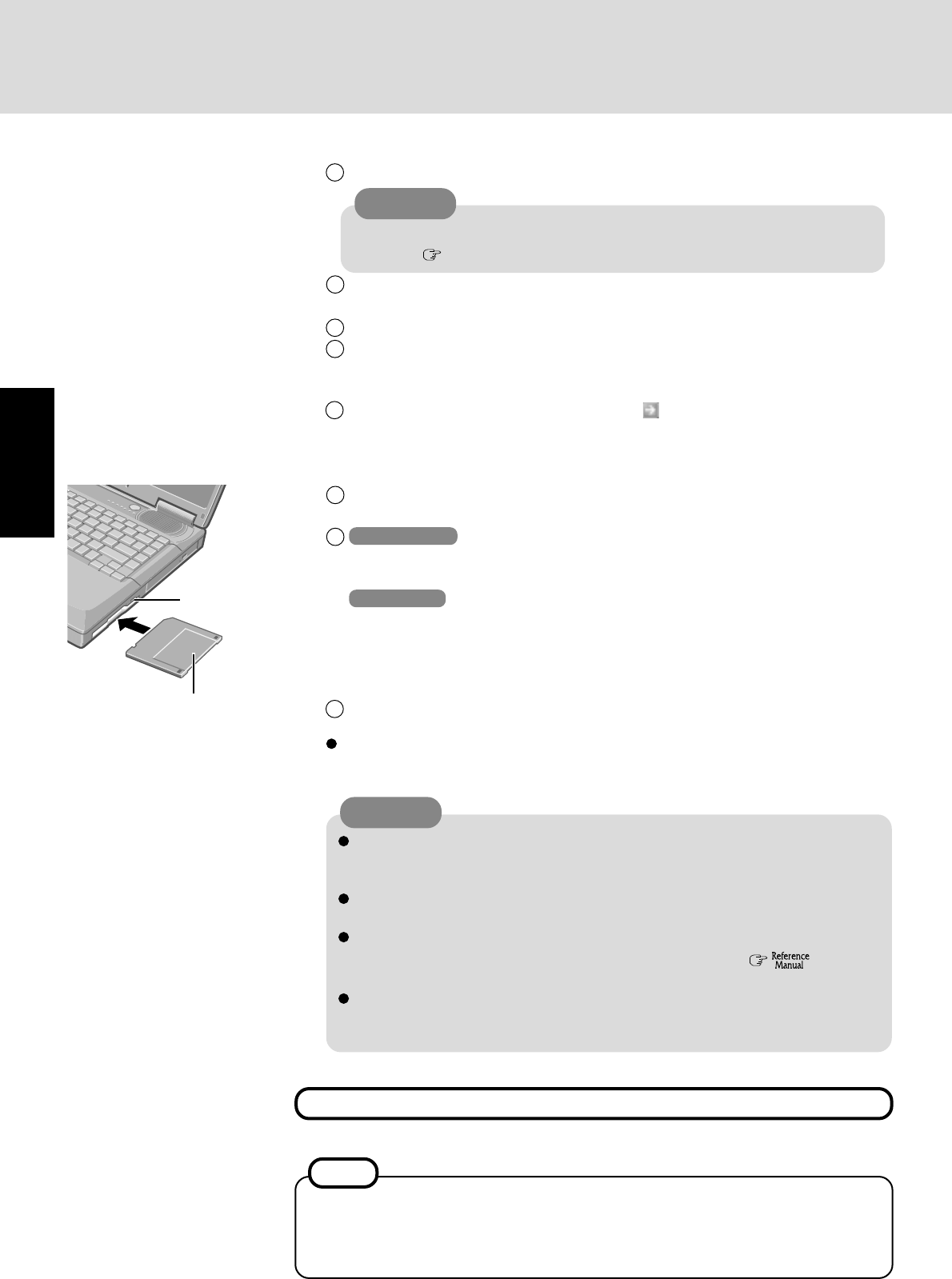
12
Getting Started
First-time Operation
8Create Backup Disks for reinstallation
1Prepare 2HD floppy disks and make sure they are not in the write-protected state, and
then set it.
2Windows 2000
Select [Start] - [Programs] - [Panasonic] - [Create Backup Disk] and follow the on-
screen instructions.
Windows XP
Select [start] - [All Programs] - [Panasonic] - [Create Backup Disk] and follow the on-
screen instructions.
When [You do not need to make “BACKUP DISK”] is displayed, there is no need to
create a Backup Disk.
3Place a label identifying the contents on each disk.
Name of created backup disk
FIRSTAID FD (When the display for creating the UPDATE FD is shown, create the
disk by following the on-screen instructions.)
Label on the top surface, and
insert the shutter-side headfirst.
5Enter your computer name and administrator password and then select [Next].
6Enter the correct date, time and the time zone, then select [Next].
You can also complete these settings at a later time.
7At the [Networking Settings], select [Typical settings], then select [Next].
8At the [Workgroup or Computer Domain], select [No, this computer is not on a net-
work, or is on a network without a domain], then select [Next].
The computer will restart.
9Enter your administrator password and select .
Eject Button
CAUTION
Remember this password! If the password is forgotten, Windows XP cannot be
operated. ( Page 13)
CAUTION
Store the floppy disks in a safe place. They will enable you to return your computer
to close to the condition at the time of purchase should any problems occur.
When creating backup disks, do not run any other application program.
When creating backup disks and the message [Insufficient files to copy] is dis-
played, select [OK] and then contact Panasonic Technical Support.
While the floppy disk drive indicator is on, do not remove the floppy disk, power
off your computer or use the standby or hibernation function ( “Standby/
Hibernation Functions”).
Be sure to create the backup disk.
If a backup disk is not created, it will be impossible to return the computer to its
original state. In this case, contact Panasonic Technical Support.
This concludes the first-time use operation guidelines.
<Information for the CD-R/RW drive and DVD-ROM & CD-R/RW drive>
Before using the CD-R/RW drive or DVD-ROM & CD-R/RW drive for the first time,
remove the protective sheet from the lens area. The protective sheet inside the drive delays
the opening of the drive by about ten seconds. This delay is not a problem.
NOTE
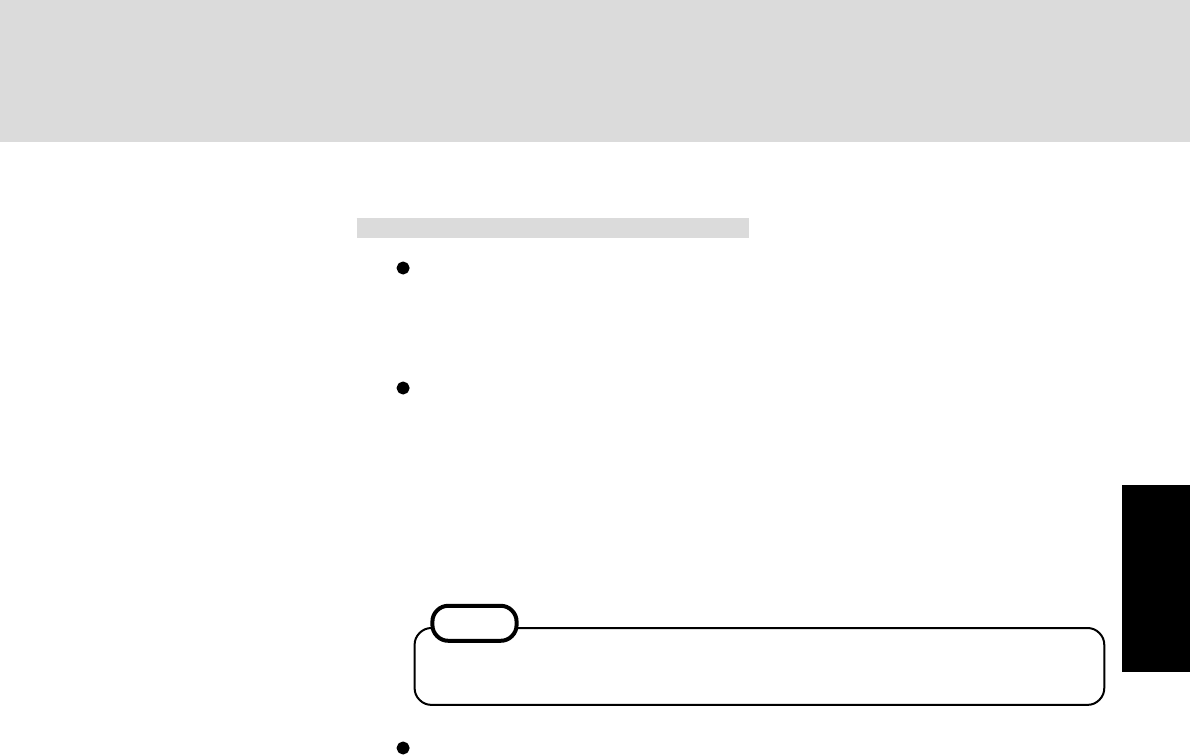
13
Getting Started
You can select Classic view for the Control Panel or select the Classic Start menu. You
can also change the way a user logs on or off.
The procedure in this manual uses the method or view of the Windows XP default
setting (not Classic view or Classic Start menu etc.).
Resetting the password
Windows XP has a function to reset a forgotten password.
To use this function, you need to create a password reset disk beforehand following the
steps below.
1Select [start] - [Control Panel] - [User Accounts] and select the account you used to
logon.
2Select [Prevent a forgotten password] from the [Related Tasks] menu and create a
password reset disk following the on-screen instructions.
Store the password reset disk in a safe place.
Depending on the Windows settings, installed applications, and drivers, menus and
other displays may differ, or some functions (such as use of the password reset disk)
may be inoperable. Check with your system administrator for details.
NOTE
Only the logon password for each account can be reset.
The password set in the Setup Utility cannot be reset.
Information for Windows XP
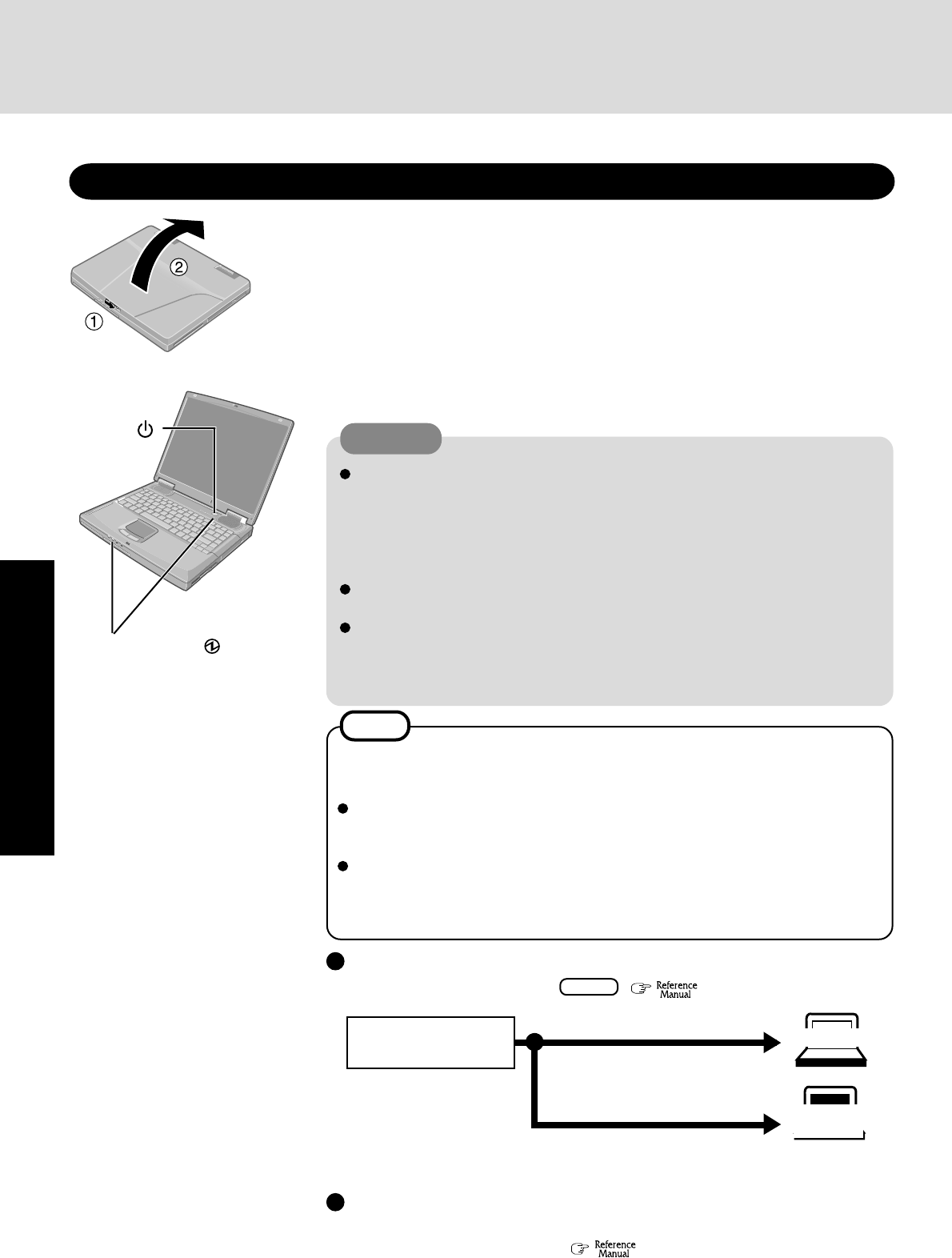
14
Operation
1Open the display
Slide the latch as shown and lift open the display.
Starting Up/Shutting Down
Starting Up
2Turn your computer on
Press the power switch and hold it for approximately one second until the power indicator
turns on before releasing it.
After confirming that the power indicator has turned on, avoid the following until
Windows has completed loading.
• Connecting or disconnecting the AC adaptor.
• Touching the power switch.
• Performing any keyboard or touch pad (or external mouse) operations.
• Closing the display.
Once the computer is powered off, you must wait at least ten seconds before pow-
ering it on again.
When the CPU temperature rises, the computer may not power on to prevent the
CPU from overheating. Should this happen, allow the computer to cool down then
switch the power on again.
If the computer still does not power on, contact Panasonic Technical Support.
When an application or file that was previously displayed ap-
pears on your screen,
the standby or hibernation mode ( “Standby/Hibernation Functions”) has
been set.
CAUTION
Enter your password* and press Enter .( “Security Measures”)
Will Start
Will Not Start
(Power off)
If [Enter Password] is displayed,
*Supervisor Password or User Password set in the Setup Utility (not
the Windows password).
Three incorrect attempts
or
No password for about a minute
The correct password
Enter Password [ ]
You may encounter the following situations when the computer is turned on at very
low temperatures. These functions are designed to prevent hard disk drive malfunc-
tions that may occur at low temperatures.
The message “Warming up the system” is displayed, and start-up takes longer than
usual (a few minutes or more).
In this case, wait for the computer to start up.
The power indicator will blink quickly (in green); in this case, the power does not
turn on, or the computer does not resume from standby or hibernation mode.
To restart the computer, leave it in an environment with a temperature of 5°C (41°F)
or more for about an hour, and try turning the power on once more.
Power
Switch
Power Indicator
NOTE
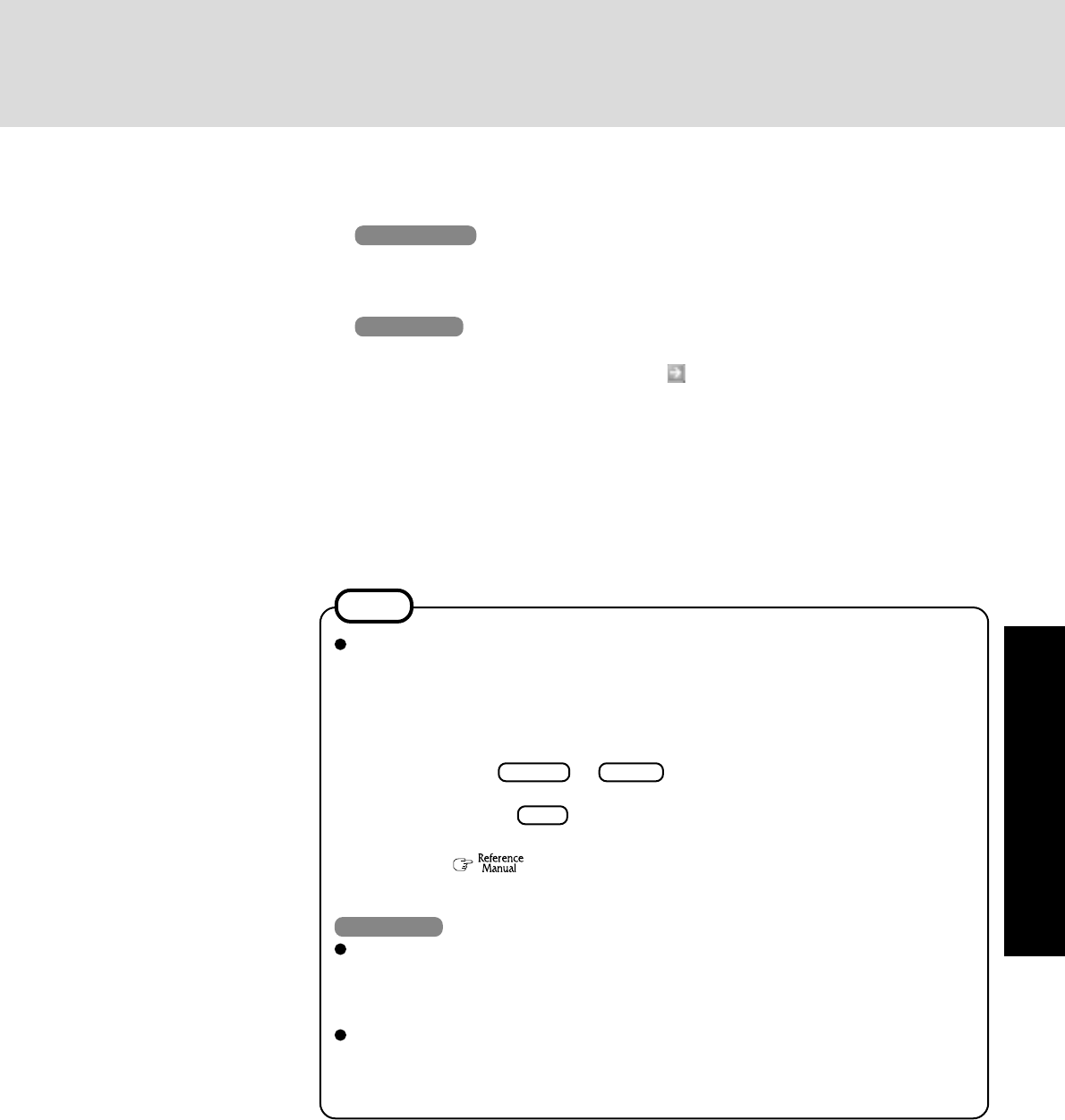
15
Operation
3Log on to Windows
Windows 2000
Wait for 10 seconds after confirming that the hard disk drive access has been completed,
input the user name and password, then select [OK]. Until the correct user name and
password are entered, the computer will not operate.
Windows XP
Wait for 10 seconds after confirming that the hard disk access has been completed, select
the user and input the password, then select . Until the correct password is entered, the
computer will not operate.
4Select your application
You are able to start working on your computer.
The power saving function is factory set, so if there is no input from a key, the touch pad
or an external mouse (when one is connected) for a certain interval of time, the power to
the LCD and hard disk may be turned off. The LCD will resume operation when the
touch pad or an external mouse (when one is connected) is used or a key is pressed.
The power to the LCD may be turned off even when an application software is being
installed. In this case, because it is conceivable that a selection dialog box will be
shown, do not press Space or Enter to attempt to resume from this condition as
doing so may trigger a selection, but instead, press a key unrelated to the direct trigger-
ing of a selection, like Ctrl .
In addition, when the computer is left alone, it automatically enters the standby or hiber-
nation mode ( “Standby/Hibernation Functions”). The computer will resume
by pressing the power switch.
Windows XP
When you create the first new account, you can only select [Computer administrator].
Only the added user account will be displayed in the Welcome screen. The account for
the administrator created during Windows setup (when the computer is started up for
the first time) will not be displayed.
When switching to a different user with the Fast User Switching function, it may not be
possible to set the settings of the display. In this case, log on with the administrator
authority again, not using the Fast User Switching function, and try the operation once
more.
NOTE
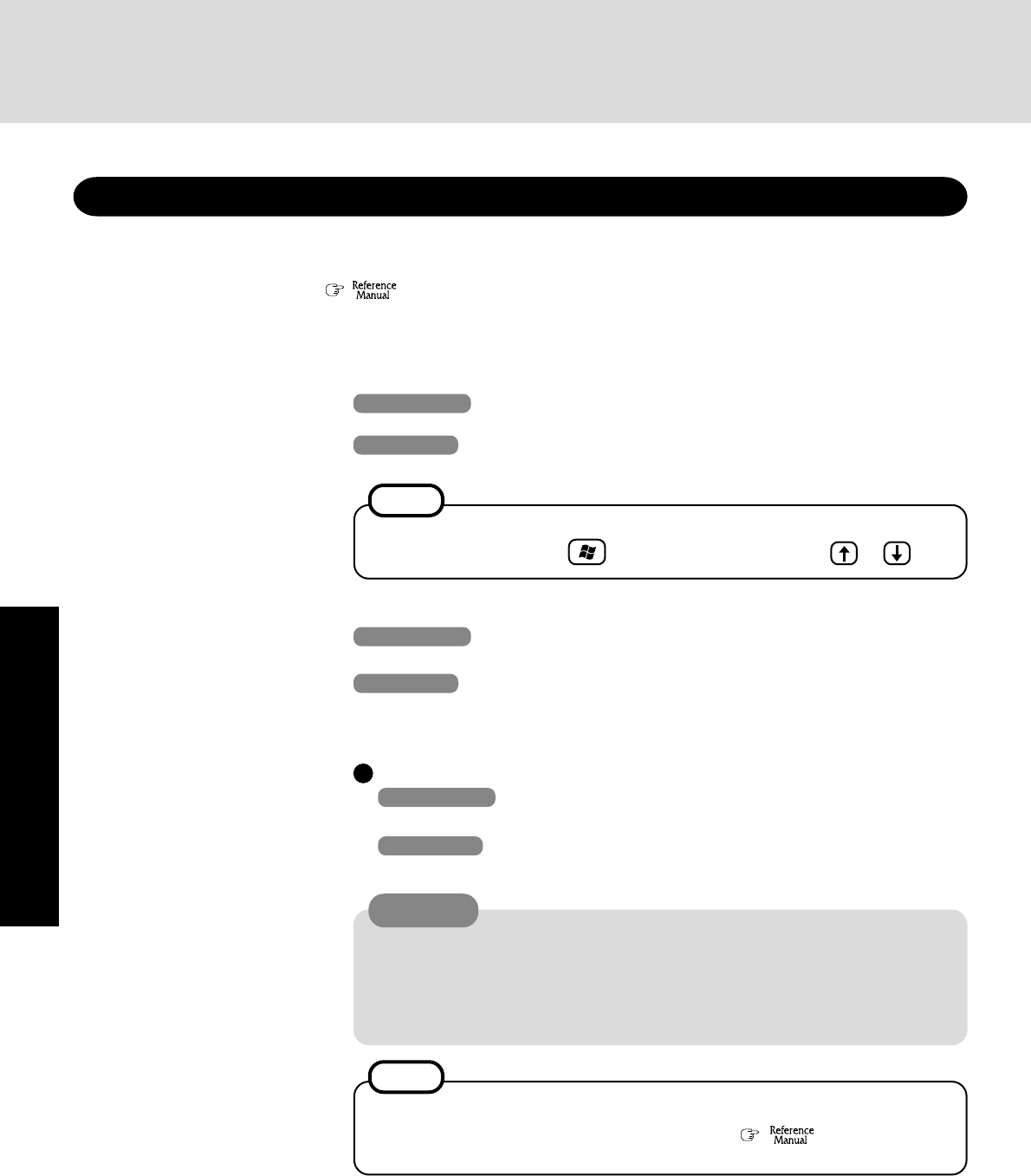
16
Operation
Shutting Down (power off your computer)
From the keyboard,
You may choose to press , and then select the menu with or .
Restarting your computer (without shutting down)
Windows 2000
Select [Restart], then select [OK].
Windows XP
Select [Restart].
3Confirm shut down
Windows 2000
Select [Shut down], then select [OK].
Windows XP
Select [Turn Off].
Your computer will power off automatically.
To quickly resume computer operation after shutting down,
The standby or hibernation function is available. ( “Standby/Hiberna-
tion Functions”)
NOTE
NOTE
Starting Up/Shutting Down
This procedure is for shutting down the computer without using the standby or hibernation
function.
(
“Standby/Hibernation Functions”
)
1Save important data and close each application
2Display the shut down screen
Windows 2000
Select [Start] - [Shut Down].
Windows XP
Select [start] - [Turn Off Computer].
CAUTION
Do not do the following during the shutdown/restart procedure.
• Connecting or disconnecting the AC adaptor.
• Touching the power switch.
• Performing any keyboard, touch pad (or external mouse) operations.
• Closing the display.
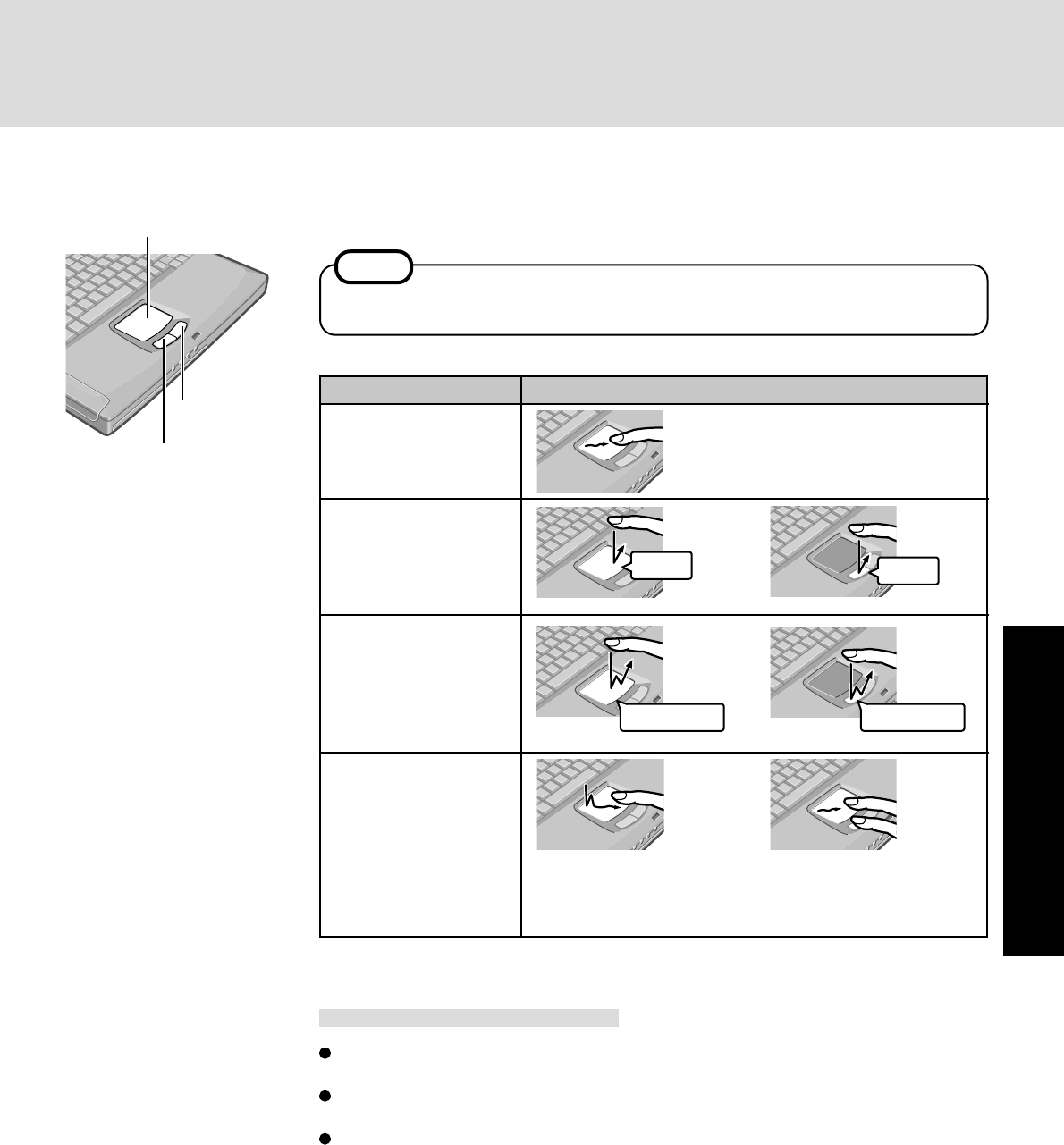
17
Operation
Function
Touch Pad
Use the touch pad to move the cursor on the display and perform normal computer operations.
Do not place any object on the work surface or press down forcefully with sharp-pointed
objects (e.g., nails) or hard objects that can leave marks (e.g., pencils and ball point pens).
Try to avoid having any harmful substances, such as oil, come in contact with the touch
pad. The cursor may not work properly in such cases.
When the touch pad becomes dirty:
Wipe to remove dirty areas by using a dry soft cloth such as gauze or a soft cloth first
applied with detergent diluted with water and then thoroughly wrung.
Do not use benzene, thinner, or disinfectant-type alcohol.
By design the touch pad is to be used with a finger tip only. Therefore, do not use any other
type implement on the touch pad, i.e. stylus, pen, or pencil eraser.
Left Button
Right Button
Work Surface
NOTE
or
Two quick taps, but on the sec-
ond tap leaving your finger
down (applying pressure) and
moving it on the work surface.
While holding down the but-
ton, moving your finger on
the work surface.
or
Touch Pad Operation
Moving the Cursor
Tapping/Clicking
Double-Tapping/
Double-Clicking
Dragging
or
Move the tip of your finger
lightly over the surface.
tapping clicking
double-tapping double-clicking
Handling the Touch Pad
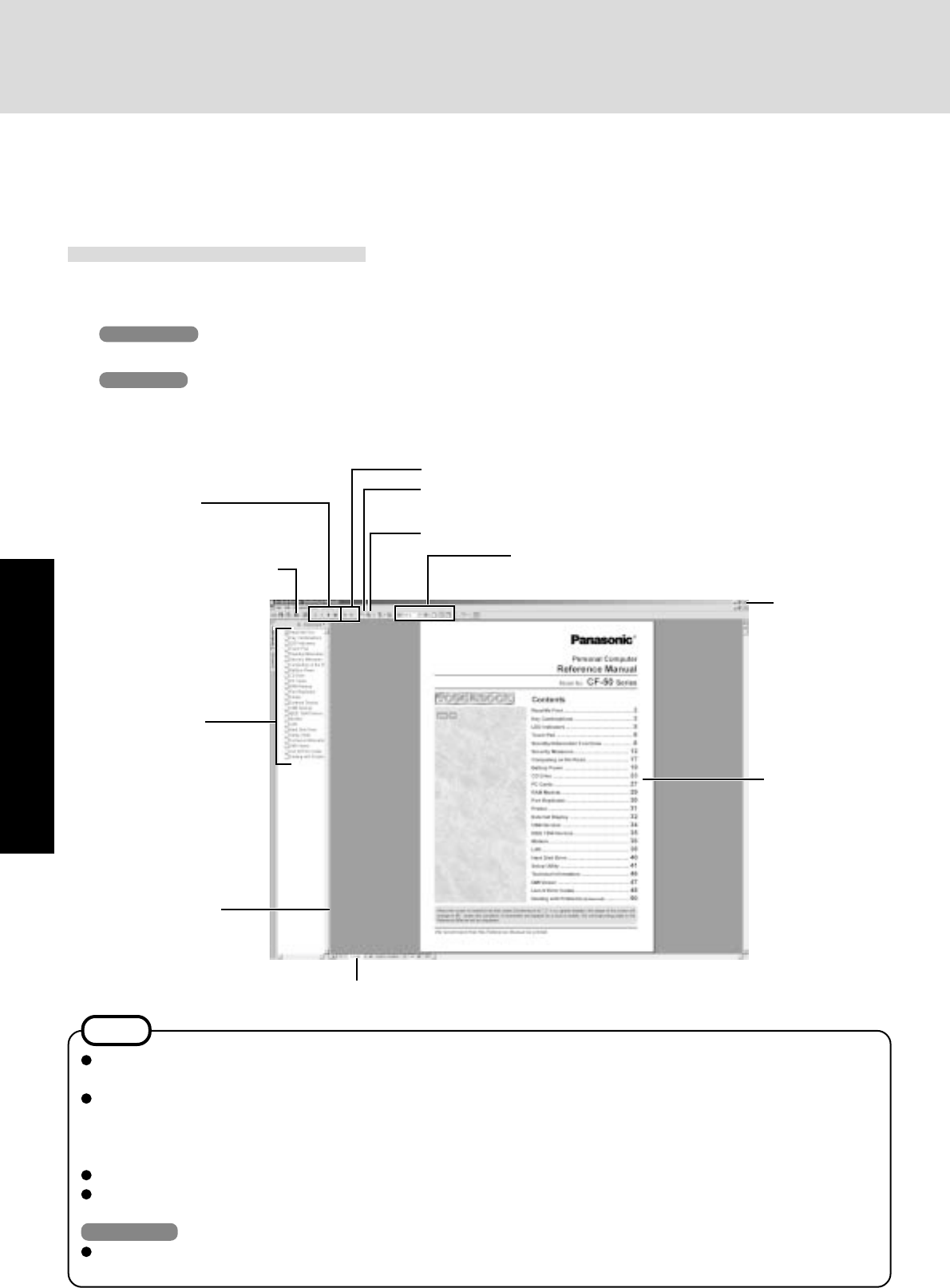
18
Operation
Table of Contents
(Items)
By clicking an item, the cor-
responding page will be dis-
played at 100%.
Reference Manual
1Turn your computer on
2Windows 2000
Select [Reference Manual] in [Start] - [Programs] - [Panasonic] - [On-Line Manuals]
Windows XP
Select [Reference Manual] in [start]
When the Reference Manual is started up for the first time, the License Agreement of the Acrobat Reader will be displayed. After
reading the agreement, select [Accept] to access the Reference Manual.
The Reference Manual can be accessed on your computer. When a printer is connected, the Reference Manual can also be printed.
This manual explains functions for you to make greater use of the computer, such as how to add peripheral devices, how the Setup
Utility works and other useful information.
Run the Reference Manual
Page indicator
A desired page can be displayed by inputting the page number after clicking here.
(The display may be changed without notification.)
Display the page
Go forward or backward a page, or to
the beginning or end of a document.
Display of
the manual
Movable splitter bar
This bar can be dragged, for
example, to the right to en-
large the display of the Table
of Contents.
Change the display size
You can select to magnify/de-magnify the display.
Exit
Perform a “Find” operation
Illustrations may be difficult to view depending on the magnification. If this is the case, we recommend that the display be
magnified.
The characters in PDF files (such as the Reference Manual) may be difficult to read depending on the Acrobat Reader
settings and the Windows Desktop settings. In such cases, change the Acrobat Reader settings with the following procedure.
1Start up Acrobat Reader.
2Select [Edit] - [Preferences] - [Accessibility], and then set [Color Scheme] to [Use colors specified in document].
When the taskbar is hidden at the bottom portion of Acrobat Reader, set the maximum display window size.
If a printer is connected, we recommend printing pages. The illustrations and display samples may not print with a high
quality.
Windows XP
When switching to a different user with the Fast User Switching function, PDF files may not be printed properly. In this case,
log on with the administrator authority again, not using the Fast User Switching function, and try the operation once more.
NOTE
Cancel or correct an operation
Zoom-in
Hand tool
To move around the current page.

19
Troubleshooting
List of Error Codes
The following is a list of the messages that BIOS can display. Most of them occur during POST. Some of them display informa-
tion about a hardware device, e.g., the amount of memory installed. Others may indicate a problem with a device, such as the way
it has been configured. Following the list are explanations of the messages and remedies for reported problems.
If your system displays any of the below error messages other that the ones marked with an asterisk (*), write down the message
and contact Panasonic Technical Support. If your system fails after you make changes in the Setup menus, reset the computer,
enter Setup and install Setup defaults or correct the error.
0200 Failure Fixed Disk
Fixed disk in not working or not configured properly. Check to see if fixed disk is attached properly. Run Setup. Find out
if the fixed-disk type is correctly identified.
0210 Stuck key
Stuck key on keyboard.
0211 Keyboard error
Keyboard not working.
0212 Keyboard Controller Failed
Keyboard controller failed test. May require replacing keyboard controller.
0213 Keyboard locked - Unlock key switch
Unlock the system to proceed.
0230 System RAM Failed at offset : nnnn
System RAM failed at offset nnnn of the 64k block at which the error was detected.
0231 Shadow RAM Failed at offset : nnnn
Shadow RAM failed at offset nnnn of the 64k block at which the error was detected.
0232 Extended RAM Failed at offset : nnnn
Extended memory not working or not configured properly at offset nnnn.
0250 System battery is dead - Replace and run SETUP
The CMOS clock battery indicator shows the battery is dead. Replace the battery and run Setup to reconfigure the system.
*0251 System CMOS checksum bad - Default configuration used
System CMOS has been corrupted or modified incorrectly, perhaps by an application program that changes data
stored in CMOS. The BIOS installed Default SETUP Values. If you do not want these values, enter Setup and enter your
own values. If the error persists, check the system battery or contact Panasonic Technical Support.
0260 System timer error
The timer test failed. Requires repair of system board.
0270 Real time clock error
Real-time clock fails BIOS test. May require board repair.
*0280 Previous boot incomplete - Default configuration used
Previous POST did not complete successfully. POST loads default values and offers to run Setup. If the failure was caused
by incorrect values and they are not corrected, the next boot will likely fail. On systems with control of wait states, improper
Setup settings can also terminate POST and cause this error on the next boot. Run Setup and verify that the wait-state
configuration is correct. This error is cleared the next time the system is booted.
0281 Memory Size found by POST differed from EISA CMOS
Memory size found by POST differed from EISA CMOS.
02B0 Diskette drive A error
02B1 Diskette drive B error
Drive A: or B: is present but fails the BIOS POST diskette tests. Check to see that the drive is defined with the proper
diskette type in Setup and that the diskette drive is attached correctly.
02B2 Incorrect Drive A type - run SETUP
Type of floppy drive A: not correctly identified in Setup.
02B3 Incorrect Drive B type - run SETUP
Type of floppy drive B: not correctly identified in Setup.
02D0 System cache error - Cache disabled
Contact Panasonic Technical Support.
02F0: CPU ID:
CPU socket number for Multi-Processor error.
02F4: EISA CMOS not writable
ServerBIOS2 test error: Cannot write to EISA CMOS.

20
Troubleshooting
02F5: DMA Test Failed
ServerBIOS2 test error: Cannot write to extended DMA (Direct Memory Access) registers.
02F6: Software NMI Failed
ServerBIOS2 test error: Cannot generate software NMI (Non-Maskable Interrupt).
02F7: Fail - Safe Timer NMI Failed
ServerBIOS2 test error: Fail-Safe Timer takes too long.
device address Conflict
Address conflict for specified device.
Allocation Error for: device
Run ISA or EISA Configuration Utility to resolve resource conflict for the specified device.
Failing Bits : nnnn
The hex number nnnn is a map of the bits at the RAM address which failed the memory test. Each 1 (one) in the map
indicates a failed bit. See error 230,231 or 232 for offset address of the failure in System, Extended or Shadow memory.
Invalid System Configuration Data
Problem with NVRAM (CMOS) data.
I/O device IRQ conflict
I/O device IRQ conflict error.
Operating System not found
Operating system cannot be located on either drive A: or drive C:. Enter Setup and see if fixed disk and drive A: are properly
identified.
Parity Check 1 nnnn
Parity error found in the system bus. BIOS attempts to locate the address and display it on the screen. If it cannot locate the
address, it displays ????. Parity is a method for checking errors in binary data. A parity error indicates that some data has
been corrupted.
Parity Check 2 nnnn
Parity error found in the I/O bus. BIOS attempts to locate the address and display it on the screen. If it cannot locate the
address, it displays ????.
Press <F1> to resume, <F2> to Setup
Displayed after any recoverable error message. Press <F1> to start the boot process or <F2> to enter a Setup and change the
settings. Write down and follow the information shown on the screen.
List of Error Codes
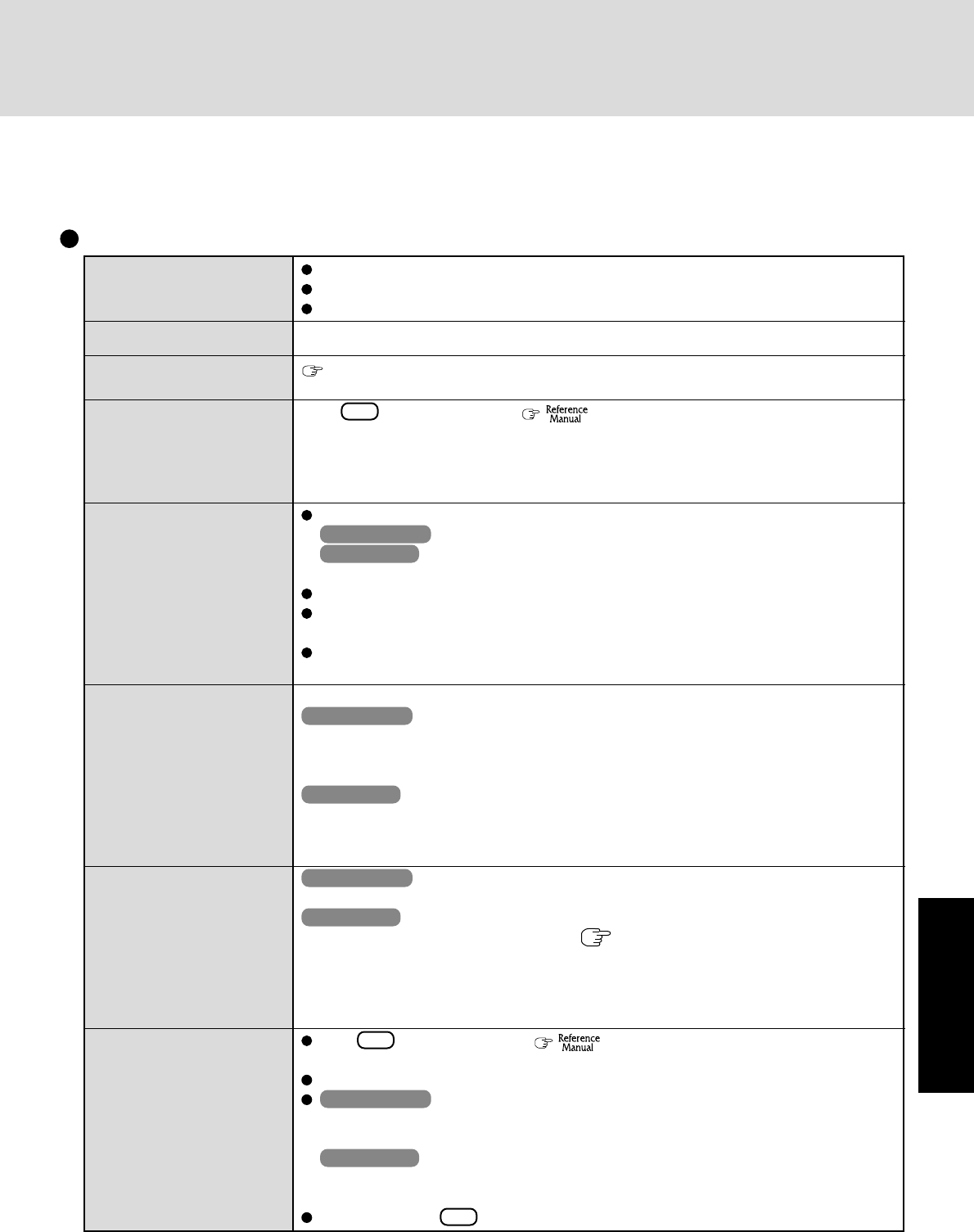
21
Troubleshooting
The power indicator or bat-
tery indicator is not lit
[Enter Password] is displayed
POST Startup Error(s) is
displayed
Windows startup, or an op-
eration is extremely slow
The date and time are incor-
rect
When resuming from the
standby or hibernation
mode, [Enter Password]
does not appear even if a
password has been set in the
Setup Utility
When the administrator
password is forgotten
When the previous item is
not the cause
Check the cable connection for the AC adaptor.
Check to see if a fully charged battery is properly installed.
Remove the battery pack and disconnect the AC adaptor, then connect them again.
Input your password. If you have forgotten it, contact Panasonic Technical Support.
page 19
Press F9 in the Setup Utility ( “Setup Utility”). This will restore the Setup
Utility’s settings to their default values (except the password settings). Then, the Setup
Utility must be run once again for you to input the appropriate operating environment set-
tings. (The processing speed depends on the application software used, so this operation
may not cause the processing speed to increase.)
You can set the date and time using the following menu.
Windows 2000 : [Control Panel] - [Date/Time]
Windows XP : [Control Panel] - [Date, Time, Language, and Regional Options] -
[Date and Time]
When the computer is connected to a LAN, confirm the date and time of the server.
If you continue to experience problems, the internal battery maintaining the clock may
need to be replaced. Contact Panasonic Technical Support.
This computer will not correctly recognize the date and time starting from the year 2100
A.D.
Use the Windows password as follows:
Windows 2000
Set the password in [Control Panel] - [Users and Passwords], then add the check mark for
[Prompt for password when computer goes off standby] in [Control Panel] - [Power Op-
tions] - [Advanced].
Windows XP
Select the account to change in [Control Panel] - [User Accounts] and set the password, then
add the check mark for [Prompt for password when computer resumes from standby] in
[Control Panel] - [Performance and Maintenance] - [Power Options] - [Advanced].
Windows 2000
After reinstalling, setup Windows and then set the password again.
Windows XP
If you have created a password reset disk ( page 13), a message is displayed when you
fail to correctly enter the password. Follow the message’s instructions and set the password
again by using the password reset disk.
If you have not created a password reset disk, after reinstalling, setup Windows and then set
the password again.
Press F9 in the Setup Utility ( “Setup Utility”). This will restore the Setup
Utility’s settings to their default values (except the password settings).
Try removing all peripheral devices.
Windows 2000
Click [Local Disk(C:)] with the right button in [My Computer], select [Properties], then
select [Tools] - [Check Now].
Windows XP
Click [Local Disk(C:)] with the right button in [start] - [My Computer], select [Proper-
ties], then select [Tools] - [Check Now].
At start-up, press F8 to operate the computer in the Safe mode.
When a problem occurs, refer to this page. The “Reference Manual” also contains detailed information. If a problem appears to be
related to a software application, read the software related manual. If you still cannot troubleshoot the problem, contact Panasonic
Technical Support.
Dealing with Problems (Summary)
Starting Up
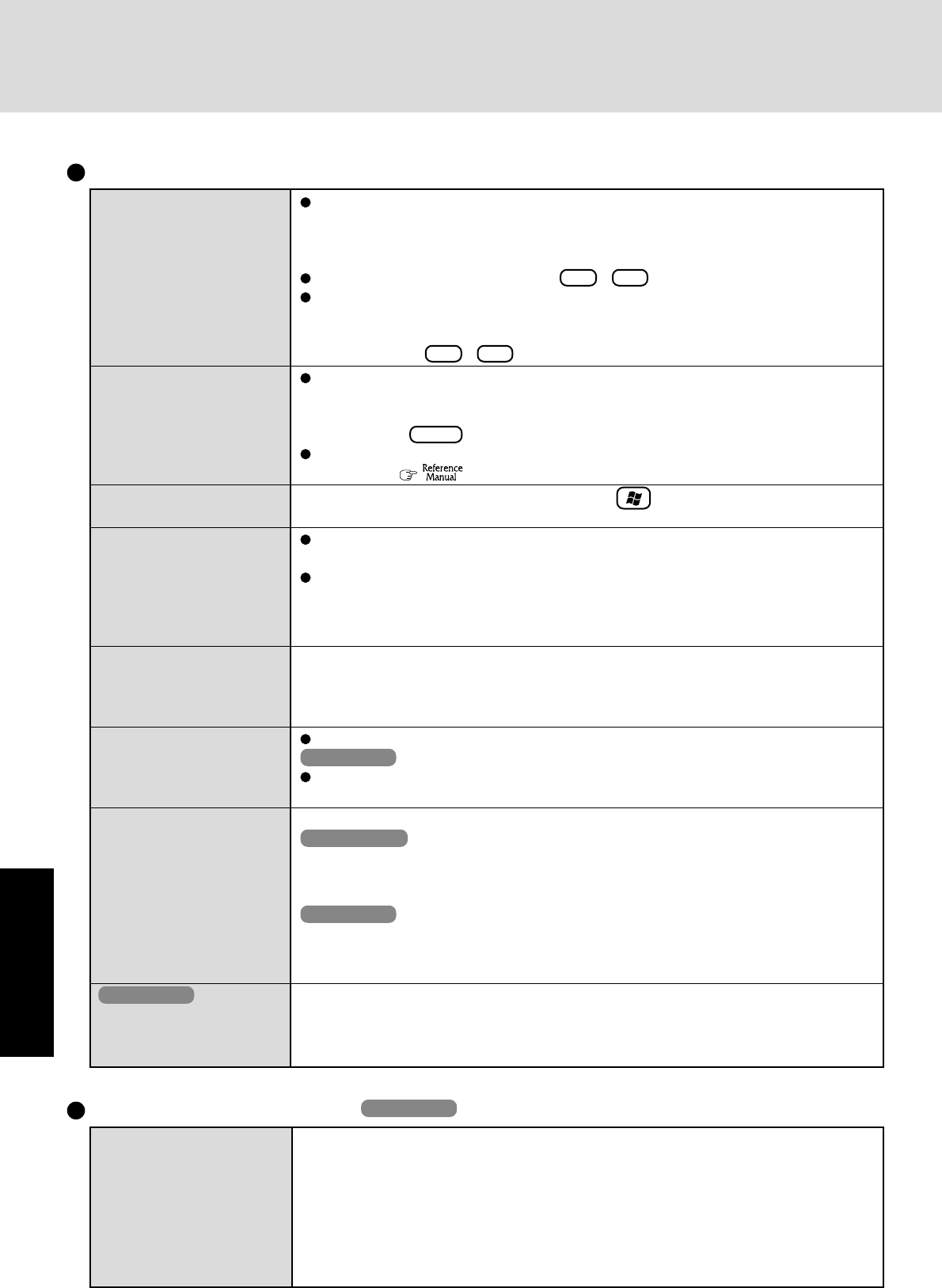
22
Troubleshooting
No display after powering on
The power has not been
turned off, but after a cer-
tain period of time, there is
no display
The cursor cannot be con-
trolled
An afterimage appears (e.g.,
green, red, and blue dots
remain on the display) or
there are dots not display-
ing the correct colors.
The external display no
longer displays properly
The screen becomes disor-
dered
When you want to display
the fonts or icons at a larger
size
Windows XP
An error occurs or the com-
puter freezes while using
Dualview.
Dealing with Problems (Summary)
When there is no display to an external display,
• Check your cable connection to the external display.
• Confirm your display is powered on.
• Check the settings for your external display.
Try changing the display by pressing Fn + F3 .
When displaying only through an external display, if the computer is shut down by using
the standby or hibernation function, there will be no display on the LCD unless the exter-
nal display is connected when operations are resumed. In this case, connect the external
display or press Fn + F3 .
Has the computer been set to the power-saving mode?
To resume operation of your computer from the condition the power of the display is off
(for energy conservation purposes), press any key unrelated to the direct triggering of a
selection, like Shift .
To save power, your computer may have automatically entered the standby or hiberna-
tion mode. ( “Computing On the Road”) Press the power switch.
Restart the computer by using the keyboard (e.g., ).
If an image is displayed for a prolonged period of time, an afterimage may appear. This
is not a malfunction. The afterimage will disappear when a different screen is displayed.
High-precision and advanced technologies are necessary in the production of color liquid
crystal displays (color LCDs). Therefore, if 0.002% or less of the picture elements either
fail to light or remain constantly lit (that is, more than 99.998% of elements are function-
ing properly), no defect is considered to exist.
When an external display not compatible with the power saving mode is used with the
computer, the external display may no longer display properly when the computer enters the
condition the power of the display is OFF (for energy conservation purposes). In such
cases, turn off the power to the external display.
Changing the number of colors of the display may affect the screen. Restart the computer.
Windows XP
When using Dualview, use the same display colors for the external display as those used
by the LCD.
Change the settings as follows (for more details, refer to the Windows Help).
Windows 2000
1Select [Start] - [Settings] - [Control Panel] - [Display] - [Appearance].
2Select the scheme labeled “large” or “extra large” in [Scheme] to change the font size,
and select [Icon] in [Item] to change the icon size.
Windows XP
1Select [start] - [Control Panel] - [Appearance and Themes] - [Display] - [Appearance].
2Select the font size in [Font size], and select [Effects] and then add the check mark for
[Use large icons] to increase the icon size.
If you use a 3D screen saver while in Dualview mode at a high resolution, an error may
occur or the computer may freeze. Under these conditions, do not use a 3D screen saver.
Display
Some applications do not
work properly When switching to a different user with the Fast User Switching function, the following
problems may occur.
• Some applications may not work properly (for example, PDF files may not be printed
properly).
• It may not be possible to set the settings of the display.
• A serial mouse may not work.
If any of the above occur, log on with the administrator authority again, not using the Fast
User Switching function, and try the operation once more.
Fast User Switching function Windows XP
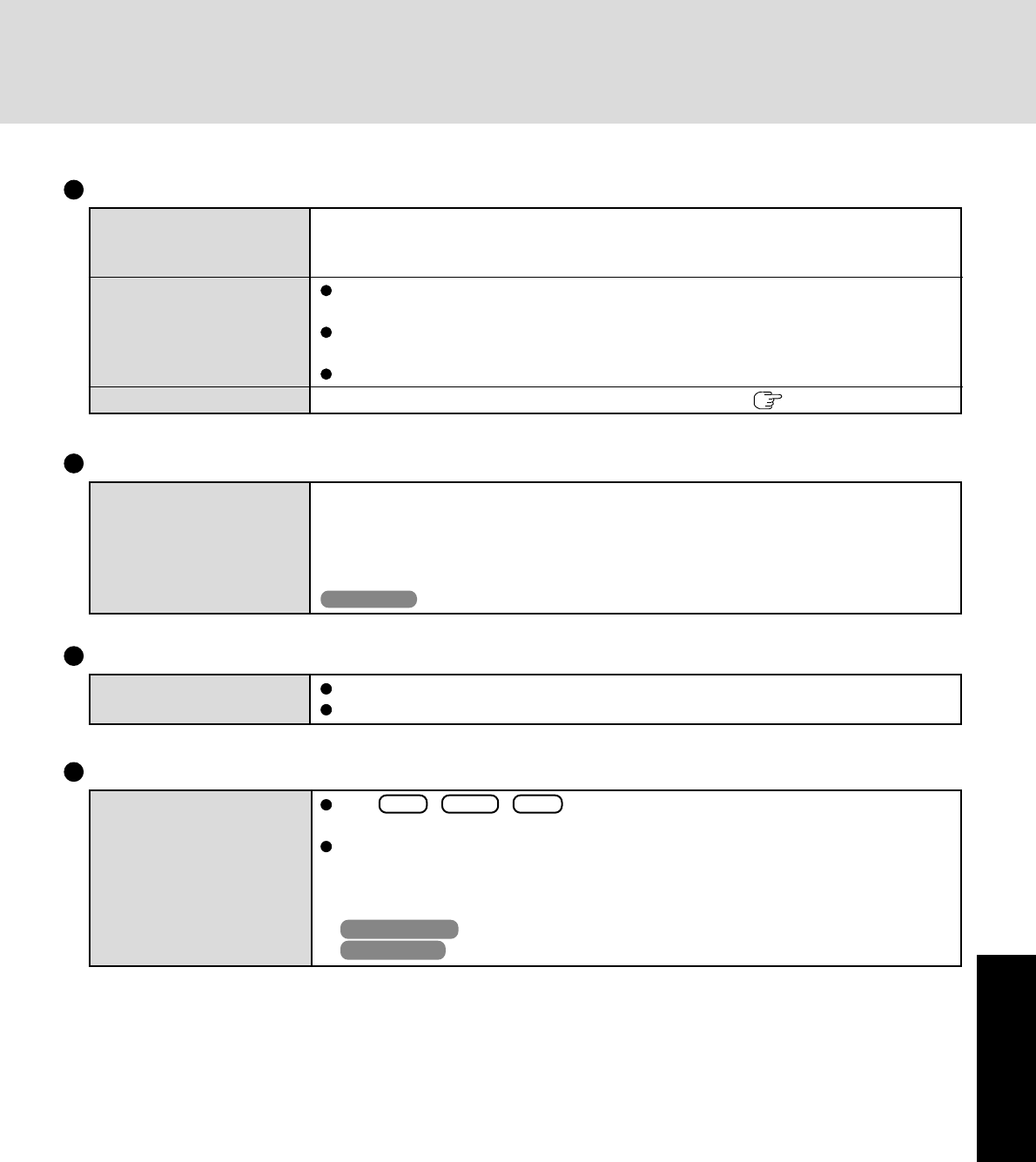
23
Troubleshooting
The red indicator lights.
The red indicator blinks
The orange indicator blinks
Windows cannot be shut
down or restarted
Shutting down
Do not shut down Windows during music playback.
If a USB device is connected, try removing it.
Is Acrobat Reader installed?
If Acrobat Reader is not installed, run [c:\util\reader\ar505enu.exe] in [Start]* - [Run] to
reinstall the program. When installing the program, do not change the installation destina-
tion folder. If the destination folder is changed, the Reference Manual cannot be opened
from the [Start]* menu.
Windows XP : [start]
Reference Manual
The Reference Manual is
not displayed
The battery level is low. Save your data and power off your computer.
After connecting the AC adaptor or replacing the battery pack with a fully charged one, turn
your computer on.
The battery pack or recharging function may be defective. Quickly remove the battery
pack and disconnect the AC adaptor, then connect them again.
Check the model number of the battery pack. CF-VZSU18 (blue tab) cannot be used with
this computer. Use only the specified battery pack (CF-VZSU18A, yellow tab).
If the problem persists, contact Panasonic Technical Support.
Unable to charge because of an improper temperature range. ( page 6)
Battery Indicator
Others
Press Ctrl + Shift + Esc to open Task Manager and close the software application
which is not responding.
After shutting down by pressing the power switch for more than four seconds, press the
power switch to power on and open the application again.
If the program no longer works normally, delete the program using the following menu.
Then reinstall the program.
Windows 2000 : [Control Panel] - [Add/Remove Programs]
Windows XP : [Control Panel] - [Add or Remove Programs]
Computer hangs
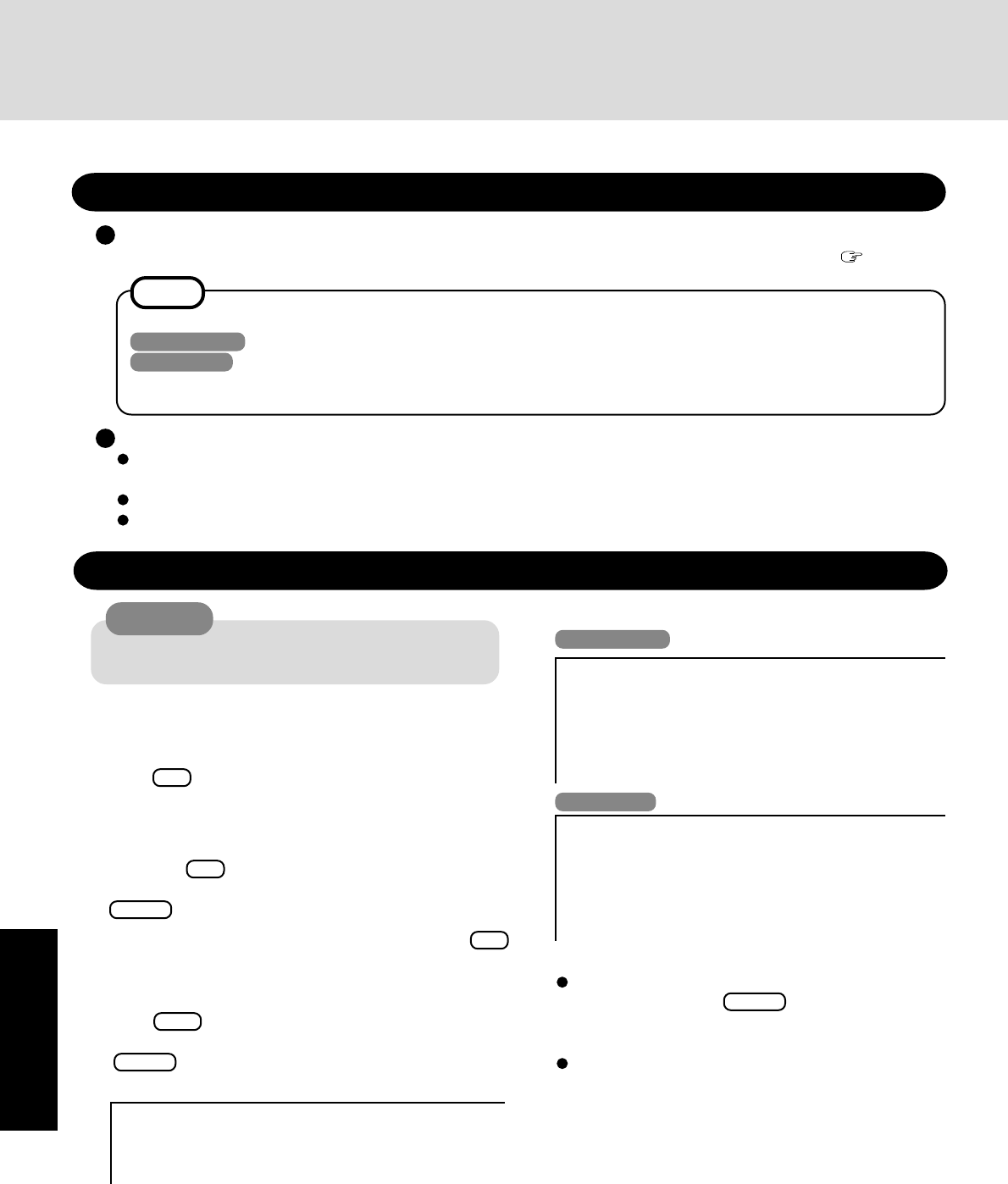
24
Troubleshooting
Reinstalling Software
Before Reinstallation
Preparing
You will need the Product Recovery CD-ROM and the Backup Disk (e.g., FIRSTAID FD) you made earlier. ( page 12)
Reinstalling
1Turn the computer on.
2When the message [Press F2 to enter SETUP] is displayed,
press F2 and then run the Setup Utility.
If the password has been set, enter the Supervisor Pass-
word.
3Write down all of the contents of the Setup Utility and
then press F9 .
At the confirmation message, select [Yes] and press
Enter .
4Select [Boot] menu, then select [CD Drive] and press F6
until [CD Drive] is at the top of the [Boot] menu.
5Place the disc one of the recovery CDs into the CD drive.
6Press F10 .
At the confirmation message, select [Yes] and press
Enter .
The computer will reboot, and this screen should appear.
Select [1. Start restoring the operating system.].
7The License Agreement screen should appear.
Select [1. Yes, I agree to the provisions above and wish to
continue!].
If data on your hard disk is compressed, the data should
be uncompressed.
Important
Save all important data. If reinstallation is carried out, all data existing prior to the installation will be lost. The reinstal-
lation will return the computer to close to the conditions at time of purchase.
Before the reinstallation procedure, remove all peripherals.
Be sure the AC adaptor is connected until the reinstallation procedure is completed.
If you have not created the FIRSTAID FD, you can create by using the following menu.
Windows 2000 : [Create Backup Disk] in [Start] - [Programs] - [Panasonic].
Windows XP : [Create Backup Disk] in [start] - [All Programs] - [Panasonic].
If you can not create this disk, contact Panasonic Technical Support.
NOTE
CAUTION
---------------------------------------------------------------------
Select a number
---------------------------------------------------------------------
1. Start restoring the operating system.
2. Erase the whole data on HDD for security.
3. End
---------------------------------------------------------------------
9Make a selection from the menu.
When selecting [2], enter the basic partition size for OS
installation and press Enter .
(The data partition size is the remainder after subtract-
ing the basic partition size.)
To select [3], the initial partition size must be 6 GB or
more of the hard disk size. Reinstallation cannot be per-
formed with a small partition size.
Windows XP
8This screen should appear.
Windows 2000
---------------------------------------------------------------------
Select a number
---------------------------------------------------------------------
1. Restore Windows(R) 2000 Professional to the whole HDD.
2. Make two partitions, for the operating system and data. And restore
Windows(R) 2000 Professional to the operating system partition.
(All existing partitions on HDD will be lost.)
3. Restore Windows(R) 2000 Professional to the first partition
4. End
---------------------------------------------------------------------
---------------------------------------------------------------------
Select a number
---------------------------------------------------------------------
1. Restore Windows(R) XP Professional to the whole HDD.
2. Make two partitions, for the operating system and data. And restore
Windows(R) XP Professional to the operating system partition.
(All existing partitions on HDD will be lost.)
3. Restore Windows(R) XP Professional to the first partition
4. End
---------------------------------------------------------------------
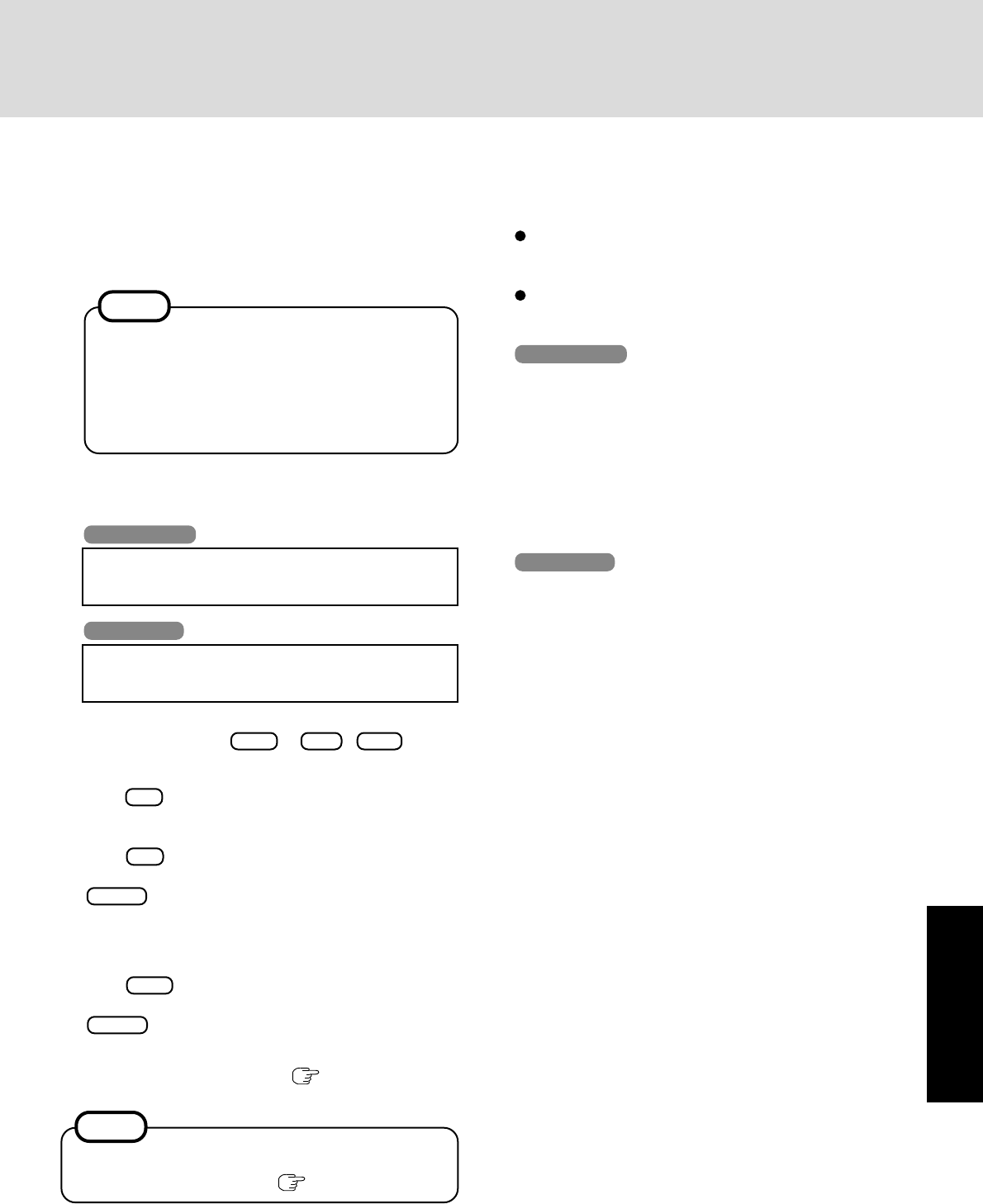
25
Troubleshooting
11 After the reinstallation procedure completes, the follow-
ing message will appear on the display.
Windows(R) 2000 Professional install wizard will start after reboot.
Remove the Product Recovery CD-ROM, then restart the computer by pressing
Ctrl + Alt + Del (Delete).
Windows 2000
10 At the confirmation message, select [Y].
The operations of reinstallation for the hard disk start au-
tomatically. (The operations take about 15 minutes.)
When the message “insert the next CD” is displayed, in-
sert the Product Recovery CD-ROM showing the next
number in the sequence, and then select [OK].
If the message “The media does not contain the cor-
rect file” appears, select [OK]. The message “insert
the next CD” will be displayed again.
Confirm that the proper Product Recovery CD-ROM
has been inserted by opening the tray of the CD drive
and then close the tray, then select [OK].
NOTE
Windows(R) XP Professional install wizard will start after reboot.
Remove the Product Recovery CD-ROM, then restart the computer by pressing
Ctrl + Alt + Del (Delete).
Windows XP
Remove the Product Recovery CD-ROM, then restart the
computer by pressing Ctrl + Alt + Del .
12 When the message [Press F2 to enter SETUP] is displayed,
press F2 and then run the Setup Utility.
If the password has been set, enter the Supervisor Pass-
word.
13 Press F9 .
At the confirmation message, select [Yes] and press
Enter . (The Setup Utility settings will return to their
default values. Even the security settings with the excep-
tion of the password(s) will return to their default values.)
Change the settings where necessary.
14 Press F10 .
At the confirmation message, select [Yes] and press
Enter .
15 Perform the setup procedure for Windows by following
the instructions on the screen. ( page 11)
NOTE
When the FIRSTAID FD is to be created, follow the steps
in the readme.txt on the disk. ( page 12)
<Changing the drive letter>
You can change the drive letter for the CD drive or hard disk
drive by the following steps.
Drive letters can only be changed when two or more parti-
tions have been created on the hard disk drive. The name
of the C: drive cannot be changed.
We recommend that you make these changes before in-
stalling applications.
Windows 2000
1Select [Start] - [Settings] - [Control Panel] - [Administra-
tive Tools] - [Computer Management].
2Select [Disk Management] from [Storage].
3Right click on the partition of the hard disk or the name of
the CD drive and select [Change Drive Letter and Path].
4Select [Edit].
5Select [Assign a drive letter] and the new drive letter, and
then select [OK].
6At the confirmation message, select [Yes].
Windows XP
1Select [start] - [Control Panel] - [Performance and Main-
tenance] - [Administrative Tools] - [Computer Manage-
ment].
2Select [Disk Management] from [Storage].
3Right click on the partition of the hard disk or the name of
the CD drive and select [Change Drive Letter and Paths].
4Select [Change].
5Select [Assign the following drive letter] and the new drive
letter, and then select [OK].
6At the confirmation message, select [Yes].

26
Appendix
YOU MAY NOT REVERSE ASSEMBLE, REVERSE COMPILE, OR MECHANICALLY OR ELECTRONICALLY TRACE
THE PROGRAMS, OR ANY COPY THEREOF, IN WHOLE OR IN PART.
YOU MAY NOT USE, COPY, MODIFY, ALTER, OR TRANSFER THE PROGRAMS OR ANY COPY THEREOF, IN
WHOLE OR IN PART, EXCEPT AS EXPRESSLY PROVIDED IN THE LICENSE.
IF YOU TRANSFER POSSESSION OF ANY COPY OF ANY PROGRAM TO ANOTHER PARTY, EXCEPT AS PERMIT-
TED IN PARAGRAPH E ABOVE, YOUR LICENSE IS AUTOMATICALLY TERMINATED.
This license is effective only for so long as you own or lease the Product, unless earlier terminated. You may terminate
this license at any time by destroying, at your expense, the Programs and related documentation together with all
copies thereof in any form. This license will also terminate effective immediately upon occurrence of the conditions
therefore set forth elsewhere in this Agreement, or if you fail to comply with any term or condition contained herein.
Upon any such termination, you agree to destroy, at your expense, the Programs and related documentation together
with all copies thereof in any form.
A. MEI hereby grants you a personal, non-transferable and non-exclusive right and license to use the Programs in
accordance with the terms and conditions stated in this Agreement. You acknowledge that you are receiving only
a LIMITED LICENSE TO USE the Programs and related documentation and that you shall obtain no title,
ownership nor any other rights in or to the Programs and related documentation nor in or to the algorithms,
concepts, designs and ideas represented by or incorporated in the Programs and related documentation, all of
which title, ownership and rights shall remain with MEI or its suppliers.
B. You may use the Programs only on the single Product which was accompanied by the Programs.
C. You and your employees and agents are required to protect the confidentiality of the Programs. You may not
distribute or otherwise make the Programs or related documentation available to any third party, by time-sharing
or otherwise, without the prior written consent of MEI.
D. You may not copy or reproduce, or permit to be copied or reproduced, the Programs or related documentation
for any purpose, except that you may make one (1) copy of the Programs for backup purposes only in support of
your use of the Programs on the single Product which was accompanied by the Programs. You shall not modify,
or attempt to modify, the Programs.
E. You may transfer the Programs and license them to another party only in connection with your transfer of the
single Product which was accompanied by the Programs to such other party. At the time of such a transfer, you
must also transfer all copies, whether in printed or machine readable form, of every Program, and the related
documentation, to the same party or destroy any such copies not so transferred.
F. You may not remove any copyright, trademark or other notice or product identification from the Programs and
you must reproduce and include any such notice or product identification on any copy of any Program.
LICENSE
TERM
YOU ACKNOWLEDGE THAT YOU HAVE READ THIS AGREEMENT, UNDERSTAND IT AND AGREE TO BE BOUND
BY ITS TERMS AND CONDITIONS. YOU FURTHER AGREE THAT IT IS THE COMPLETE AND EXCLUSIVE STATE-
MENT OF THE AGREEMENT BETWEEN US, WHICH SUPERSEDES ANY PROPOSAL OR PRIOR AGREEMENT,
ORAL OR WRITTEN, AND ANY OTHER COMMUNICATIONS BETWEEN US, RELATING TO THE SUBJECT MAT-
TER OF THIS AGREEMENT.
THE SOFTWARE PROGRAM(S) (“PROGRAMS”) FURNISHED WITH THIS PANASONIC® PRODUCT (“PRODUCT”)
ARE LICENSED ONLY TO THE END-USER (“YOU”), AND MAY BE USED BY YOU ONLY IN ACCORDANCE WITH
THE LICENSE TERMS DESCRIBED BELOW. YOUR USE OF THE PROGRAMS SHALL BE CONCLUSIVELY DEEMED
TO CONSTITUTE YOUR ACCEPTANCE OF THE TERMS OF THIS LICENSE.
Matsushita Electric Industrial Co., Ltd. (“MEI”) has developed or otherwise obtained the Programs and hereby licenses
their use to you. You assume sole responsibility for the selection of the Product (including the associated Programs) to
achieve your intended results, and for the installation, use and results obtained therefrom.
LIMITED USE LICENSE AGREEMENT

27
Appendix
A. MEI vous octroie par les présentes le droit et la licence personnels, non cessibles et non exclusifs d’utiliser les
Logiciels conformément aux termes, clauses et conditions de ce Contrat. Vous reconnaissez ne recevoir qu’un
droit limité d’utiliser les Logiciels et la documentation les accompagnant et vous vous engagez à n’obtenir aucun
droit de titre, propriété ni aucun autre droit vis-à-vis des Logiciels et de la documentation les accompagnant ni
vis-à-vis des algorithmes, concepts, dessins, configurations et idées représentés par ou incorporés dans les
Logiciels et la documentation les accompagnant, dont les titres, propriété et droits resteront tous à MEI ou à
leurs propriétaires.
B. Vous ne pouvez utiliser les Logiciels que sur le Produit unique qui est accompagné par les Logiciels.
C. Vous et vos employés ou agents êtes requis de protéger la confidentialité des Logiciels. Vous ne pouvez ni
distribuer ni mettre les Logiciels et la documentation les accompagnant à la disposition d’un tiers, par partage
de temps ou de quelque autre manière que ce soit, sans l’autorisation écrite préalable de MEI.
D. Vous ne pouvez ni copier ni reproduire ni permettre la copie ni la reproduction des Logiciels ni de la documen-
tation les accompagnant pour quelque fin que ce soit, à l’exception d’une (1) copie des Logiciels à des fins de
sauvegarde uniquement pour soutenir votre utilisation des Logiciels sur le Produit unique qui est accompagné
par les Logiciels. Vous ne pouvez ni modifier ni tenter de modifier les Logiciels.
E. Vous ne pouvez céder les Logiciels et en octroyer la licence à une autre partie qu’en rapport avec votre cession
du Produit unique qui est accompagné par les Logiciels à cette autre partie. Au moment de cette cession, vous
devez céder également toutes les copies, que ce soit sous forme imprimée ou lisible par la machine, de tous les
Logiciels ainsi que de la documentation les accompagnant, à la même partie ou détruire les copies non cédées.
F. Vous ne pouvez retirer aucune marque de droits d’auteur, marque ou autre ni aucune identification de produit
des Logiciels et vous devez reproduire et inclure toutes ces notices ou identifications de produit sur toutes les
copies des Logiciels.
Vous ne pouvez assembler en sens inverse, compiler en sens inverse ni retracer les Logiciels ni aucune de leurs
copies, de façon électronique ou mécanique, en tout ou en partie.
Vous ne pouvez utiliser, copier, modifier, altérer ni céder les Logiciels ni aucune de leurs copies, en tout ou en partie,
à l’exception de ce qui est expressément stipulé dans ce contrat.
Si vous cédez la possession de toute copie ou de tout Logiciel à une autre partie, à l’exception de ce qui est autorisé
au paragraphe E ci-dessus, votre licence est automatiquement résiliée.
Licence
Termes, clauses et conditions
Cette licence n’est effective que pour la durée de possession ou de crédit-bail du Produit, à moins d’une résiliation
antérieure. Vous pouvez résilier cette licence à tout moment en détruisant, à vos frais, les Logiciels et la documentation
les accompagnant avec toutes leurs copies, sous quelque forme que ce soit. Cette licence sera également résiliée,
avec application immédiate, si les conditions de résiliation définies ailleurs dans ce contrat se sont réalisées ou si vous
ne respectez pas les termes, clauses et conditions qui y sont contenues. Au moment de la résiliation, vous acceptez de
détruire, à vos frais, les Logiciels et la documentation les accompagnant avec toutes leurs copies, sous quelque forme
que ce soit.
Vous reconnaissez avoir lu ce contrat, en avoir compris toute la substance et avoir accepté de respecter ses termes,
clauses et conditions. Vous reconnaissez en outre qu’ils sont la description complète et exclusive du contrat conclu
entre nous, contrat qui remplace et annule toute proposition ou contrat précédent, écrit ou oral, et toute autre commu-
nication entre nous, relativement à l’objet du présent contrat.
Le(s) logiciel(s) (les “Logiciels”) fournis avec ce produit Panasonic® (le “Produit”) sont exclusivement concédés en
licence à l’utilisateur ultime (“vous”), et ils ne peuvent être utilisés que conformément aux clauses contractuelles ci-
dessous. En utilisant les logiciels, vous vous engagez de manière définitive à respecter les termes, clauses et condi-
tions des présentes.
Matsushita Electric Industrial Co., Ltd. (“MEI”) a mis au point ou obtenu les Logiciels et vous en concède l’utilisation par
les présentes. Vous assumez l’entière responsabilité du choix de ce Produit (y compris des Logiciels associés) pour
obtenir les résultats escomptés, ainsi que de l’installation, de l’utilisation et des résultats obtenus.
Contrat de licence d’usage limité
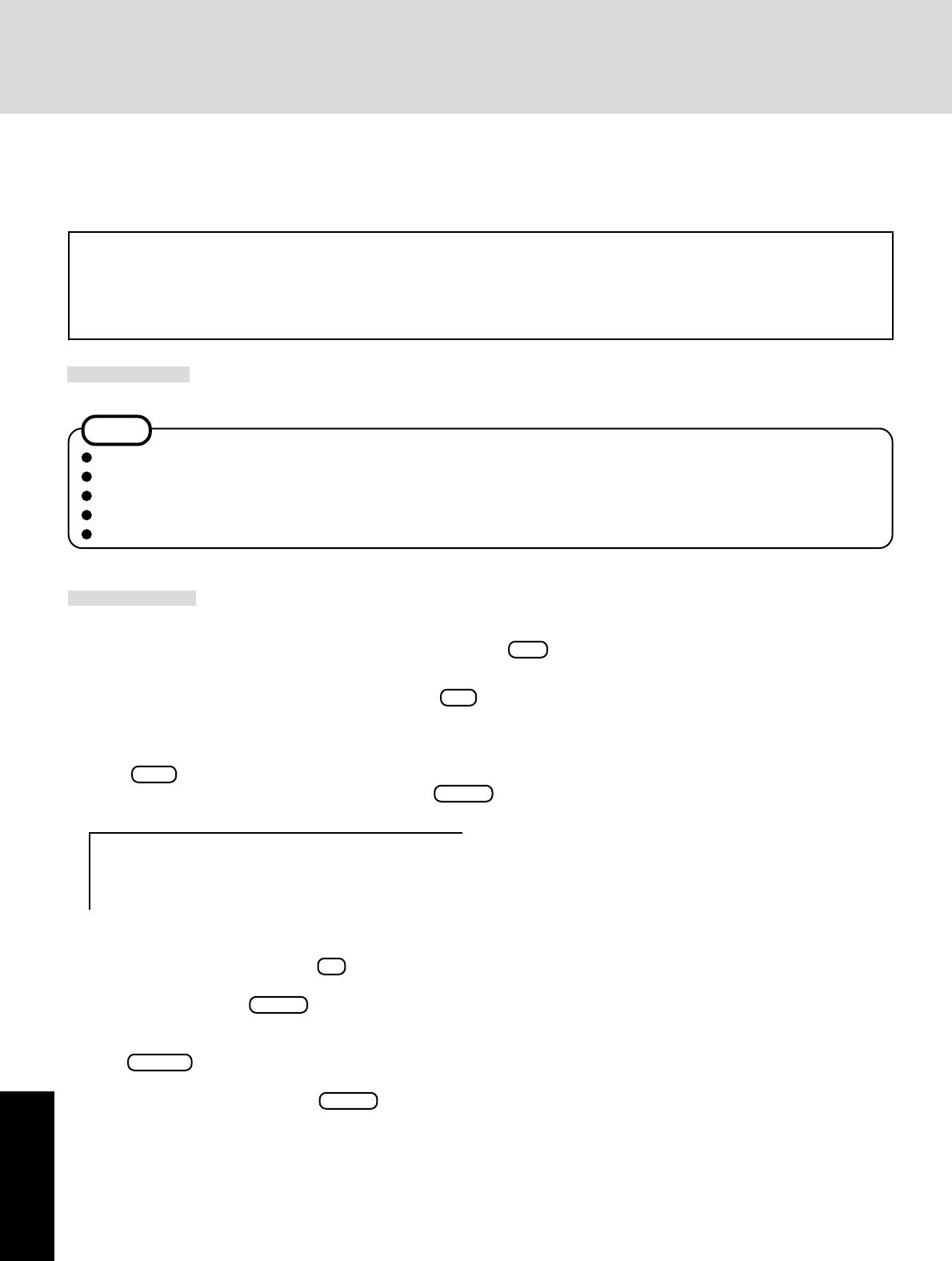
28
Appendix
1Turn the computer on.
2When the message [Press F2 to enter SETUP] is displayed, press F2 and then run the Setup Utility.
If the password has been set, enter the Supervisor Password.
3Select [Boot] menu, then select [CD Drive] and press F6 until [CD Drive] is at the top of the [Boot] menu.
4Place the disc one of the recovery CDs into the CD drive.
5Press F10 .
At the confirmation message, select [Yes] and press Enter .
The computer will reboot, and this screen should appear.
6Select [2. Erase the whole data on HDD for security.].
7At the confirmation message, press Y .
8At the start menu, press Enter .
9The time required for erasing data will be displayed.
Press Space .
10 At the confirmation message, press Enter .
The operation of erasing the hard disk starts.
11 After the operation is complete:
Under normal conditions, the message [Hard disk data has been deleted.] will be displayed.
If a problem occurred during the operation, an error message will be displayed.
12 Remove the Product Recovery CD-ROM, then turn off the computer by pressing the power switch.
This computer is equipped with a utility for completely erasing hard disk data.
When disposing of or transferring ownership of this device, erase all data on the hard disk in order to prevent the theft of hard disk
data following the steps below.
The hard disk data erase utility erases data using an “overwriting” method, but there is a possibility that due to malfunctions or
other operational errors, data may not be completely erased. There are also specialized devices that may be able to read data
that has been erased using this method. If you need to erase highly confidential data, we recommend that you contact a
company that specializes in this process. Matsushita Electric Industrial Co., Ltd. will bear no responsibility for losses or
damages suffered as a result of the use of this utility.
Preparing
You will need the Product Recovery CD-ROM.
---------------------------------------------------------------------
Select a number
---------------------------------------------------------------------
1. Start restoring the operating system.
2. Erase the whole data on HDD for security.
3. End
---------------------------------------------------------------------
NOTE
Be sure the AC adaptor is connected until the procedure is completed.
This utility can only be used for internal hard disk. It cannot be used to erase data from external hard disks.
This utility cannot erase data from damaged disk.
This utility cannot erase data for specific partitions.
After executing this utility, the computer cannot be booted from the hard disk.
Hard Disk Data Erase Utility
Procedure
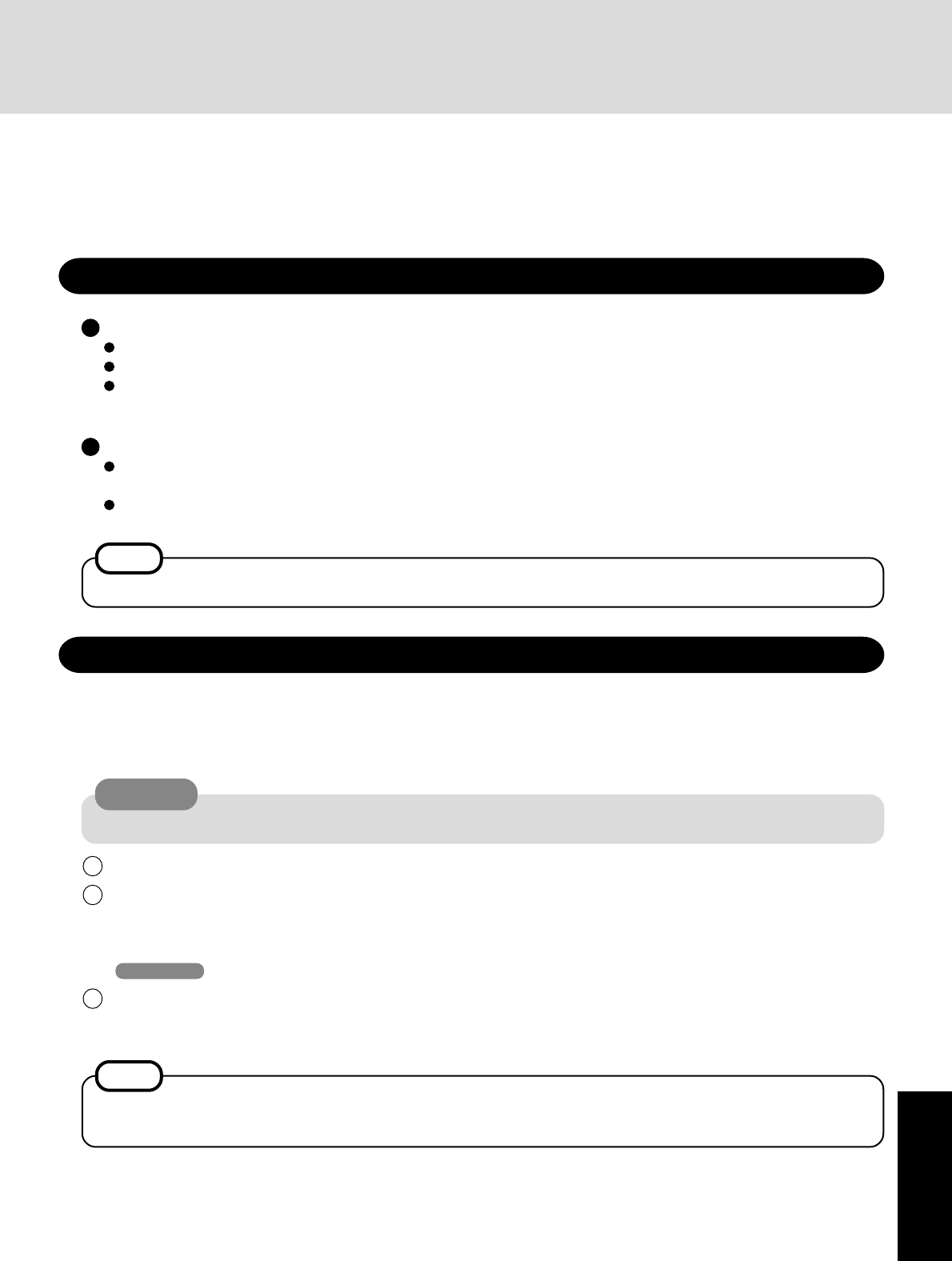
29
Appendix
Easy CD Creator TM 5
<Model with a CD-R/RW drive / Model with a DVD-ROM & CD-R/RW drive>
“Easy CD CreatorTM 5”(hereafter, Easy CD Creator) is CD writing software application developed by Roxio, Inc.
Here, explanations are given on general information about Easy CD Creator, the installation procedure, and how to access the
online manual. Refer to the online manual concerning the detailed use of the software application.
What you can do with this software application
Creation of music CDs
Creation of data CDs (CD-ROMs)
Creation of data CDs (writing files to CD-R and CD-RW discs like writing to floppy disks, etc. To do this, use DirectCD
Utility.)
Applicable CD Media
CD-R (CD-Recordable: one-time writable CD media)
Once data is written, it cannot be changed.
CD-RW (CD-ReWritable: rewritable CD media)
Written data can be deleted and new information can be added.
General Information
NOTE
For details on the functions of the software application and CD media, refer to the online manual of the application as well.
Close all other software application before running the Setup program for Easy CD Creator for added safety.
1Set the Easy CD Creator CD-ROM in the CD-R/RW drive.
2Select [Yes] at [Roxio Easy CD Creator 5].
<When the [Roxio Easy CD Creator 5] is not automatically displayed>
In [Start]* - [Run], input [x:\SETUP] and select [OK].
(“x” is the drive letter. You can change the letter to suit your preference.)
*Windows XP :[start]
3Select your language at [Choose Setup Language], then select [OK].
Follow the on-screen instructions.
When the installation completes, remove the CD-ROM from the drive.
(First time only)
Easy CD Creator is not pre-installed in the computer. To install the software application, follow the procedure below.
If you accidentally delete Easy CD Creator, or if you use the product recovery CD-ROMs and completely return the computer
to factory condition, follow the procedure below to re-install the software application.
Installing Easy CD Creator
CAUTION
NOTE
When the Easy CD Creator is started up for the first time, the License Agreement is displayed. After reading the agreement,
select [I accept the terms in the license agreement], then select [OK].

30
Appendix
How to access the Online Manual
Refer to the following menu for information on the functions of each application.
Windows 2000 : Select [Start] - [Programs] - [Roxio Easy CD Creator 5] - [Project Selector], then select [help].
Windows XP : Select [start] - [All Programs] - [Roxio Easy CD Creator 5] - [Project Selector], then select [help].
Refer to the Help menu of each application for information about specific operations.
Running Easy CD Creator
Refer to the online manual ( described above) for information on the operation and use
of each function.
When is displayed on the taskbar, the [Auto Disconnect] screen of Dial Up may not be displayed and the computer will
continue to be connected when Internet Explorer is closed. In such cases, double-click the Dial Up icon on the taskbar
and disconnect the line.
When a new CD-R disc is inserted, Project Selector is typically displayed. If there is no display, try setting the CD-R disc
again. If there is still no display, open Project Selector from the start menu.
When selecting names for external CD drives or drives created using “virtual CD” software, use letters that come later in the
alphabet than the drive letter for the internal CD drive.
When writing data using DirectCD, remove the CD-R/RW disk, and complete the writing process before doing any of the
following:
• Shutting down or restarting Windows
• Logging off Windows or using the fast user switching function
• Entering standby or hibernation mode
Do not use the emergency hole of the CD drive when removing the disc.
NOTE
When reading data of a CD formatted with DirectCD on another computer:
• The UDF Reader installation screen is displayed.
Install the UDF Reader. Although the message on the screen indicates that the reader is for use with Windows 95 or
Windows NT, it can be installed on other operating systems as well.
• The UDF Reader installation screen is not displayed and the data cannot be read.
CDs formatted with DirectCD cannot be used with this computer. Use a data CD that was not written by DirectCD
format.
When a CD cannot be formatted with DirectCD, try formatting it by the Administrator.
Cautions on Use
Information
If Easy CD Creator does not operate properly, we recommend carefully reading the online help file first for problems with
the operating environment or operations.
If you still cannot troubleshoot the problem, contact Panasonic Technical Support.
About Copies
When writing to CD-R/RW, make sure that you are not infringing any copyrights.
It is illegal to copy audio CDs for non-personal use.
When backing up software, make sure that you are not infringing any software copyrights for that product.
Easy CD Creator TM 5

31
Appendix
<Model with a DVD-ROM drive / Model with a DVD-ROM & CD-R/RW drive>
WinDVD™ (hereafter, WinDVD) is a software application for DVD playback.
Here, you will find explanations and general information on the installation procedure and how to access the online manual.
WinDVD™
Installing WinDVD
CAUTION
Close all other software application before running the Setup program for WinDVD for added safety.
Log on as the administrator.
1Set the WinDVD CD-ROM in the drive.
The WinDVD setup program will run automatically (allow some time for disc recognition). When the setup program will
not run automatically, input [x:\setup] in [Start]* - [Run] and select [OK]. (“x”is the drive letter. You can change the letter
to suit your preference.)
*Windows XP :[start]
2Select [Next] at the Welcome Message.
3After reading the “License Agreement”*, select [Yes] if you agree to the terms.
* Refer to the “LIMITED USE LICENSE AGREEMENT” on the Operating Instructions of the computer.
4Follow the on-screen instructions and install WinDVD.
<Confirmation of the DVD-ROM drive settings>
To run WinDVD, it is necessary to make the following settings.
1Windows 2000 Select [Start] - [Settings] - [Control Panel] - [System] - [Hardware] - [Device Manager].
Windows XP Select [start] - [Control Panel] - [Performance and Maintenance] - [System] - [Hardware] - [Device Man-
ager].
2Double-click [Primary IDE Channel] for [IDE ATA/ATAPI controllers].
3Select [Advanced Settings], and confirm that [Transfer Mode] is set to [DMA if available] for [Device 0] and [Device 1].
4Double-click [Secondary IDE Channel] for [IDE ATA/ATAPI controllers] and perform as the step .
Do not enter the standby or hibernation mode while WinDVD is running.
Do not start WinDVD while the hard disk drive’s access lamp is blinking immediately after the computer was started up.
If you maximize the video display window, you can return to the original window size by double-clicking over the
images.
During video playback (while the access lamp is on), do not eject the disc.
Do not use other applications or the Command Prompt, and do not change the settings of the screen properties.
In some cases, when the number of colors for the display is increased, a message appears and the DVD cannot be played.
If this happens, reduce the number of display colors.
Immediately after resuming from a pause, frame dropping may occur depending on the operating environment or DVD
video (images or sounds are disrupted).
In the DualView (Dual-Display mode) or simultaneous (internal/external) display mode, there are times when images or
video are not displayed correctly.
During a prolonged period of rapid advance, the pause mode may be established at some point. If this happens, exit
WinDVD, and restart.
NOTE
Running WinDVD
Windows 2000
Select [Start] - [Programs] - [InterVideo WinDVD] - [InterVideo WinDVD] or double-click on the desktop.
Windows XP
Select [start] - [All Programs] - [InterVideo WinDVD] - [InterVideo WinDVD] or double-click on the desktop.
<How to access the online manual>
Select “?” of the WinDVD control panel.

32
Appendix
About Regions Setting
The regions setting can be changed for up to 5 times. After the fifth change is made, it will no longer be possible either to
change the setting or to return to the original setting.
Information
Inquires about WinDVD should be made to InterVideo, Inc.
InterVideo, Inc.
URL: http://www.intervideo.com/
E-mail: support@intervideo.com
WinDVD™
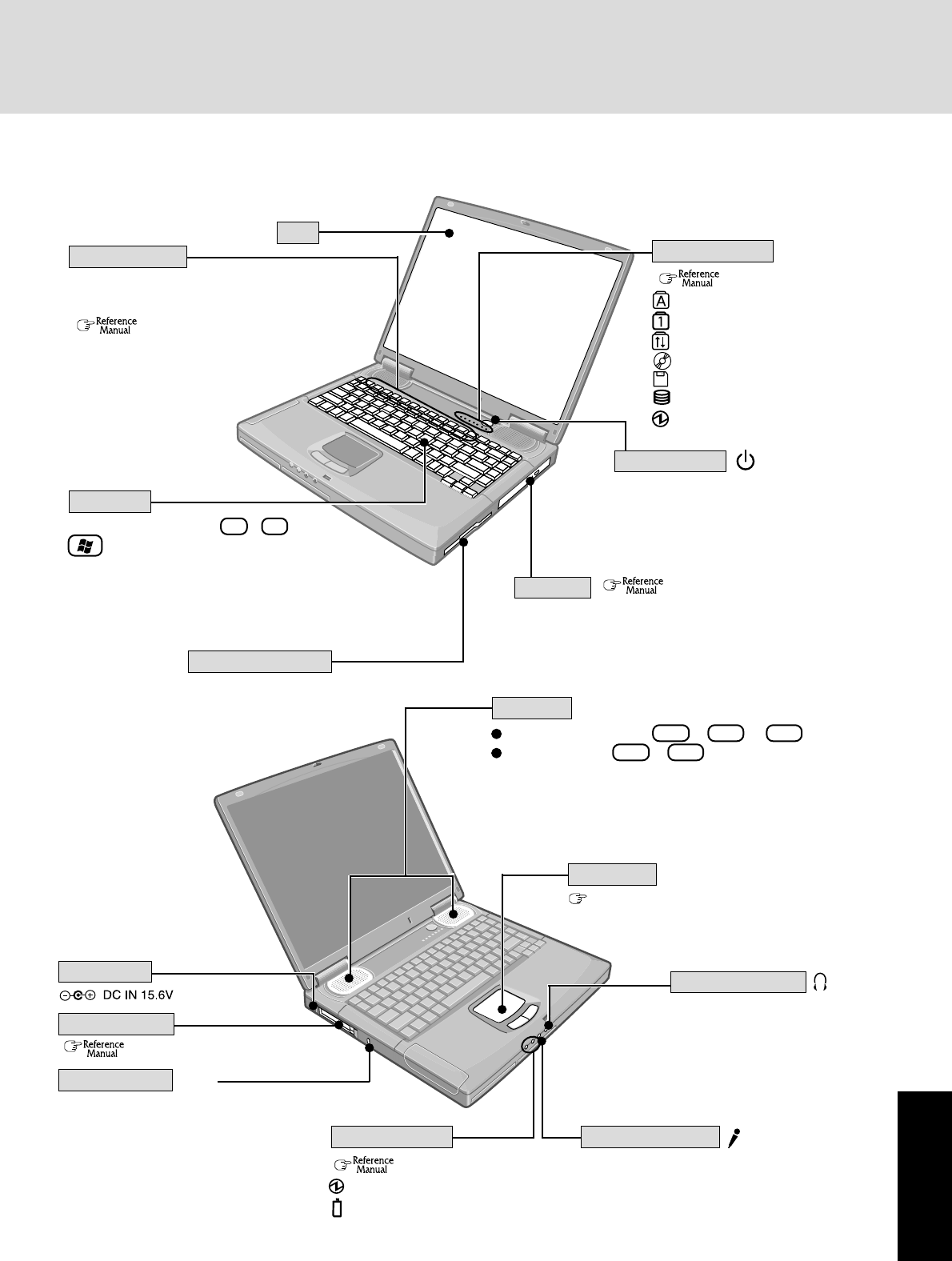
33
Appendix
Names and Functions of Parts
For information on the key combi-
nations available.
( “Key Combinations”).
There are dots near function keys
to enable you to locate the key’s
position by touch.
( “LED Indicators”)
LED Indicators
Before using the computer for the first time,
carefully read the [Limited Use License
Agreement]. If you agree to the conditions,
remove the seal.
To adjust the volume: Fn + F5 or F6
Speaker on/off: Fn + F4
Speakers
( page 17)
Touch Pad
LED Indicators
( “LED Indicators”)
Power status
Battery pack status
Use this connector to connect
headphones or amplifier-equipped
speakers. Audio output from the
internal speaker is disabled when
headphones or external speakers
are connected.
Use only a monaural condenser microphone.
Using an input source other than a monaural
condenser microphone may not allow audio to
be input or may damage the equipment.
The illustrations shown may differ from the actual physical appearances.
( “PC Cards”)
PC Card Slots
Caps Lock
Numeric key (NumLk)
Scroll lock (ScrLk)
CD drive status
Floppy disk drive status
Hard disk drive status
Power status
Function Keys
LCD
Floppy Disk Drive
Power Switch
Microphone Jack
Headphone Jack
CD Drive ( “CD Drive”)
Security Lock
A Kensington cable can be connected
to prevent theft of your computer. For
more information, please read the
manual that comes with the cable.
LOCK
DC-IN Jack
Keyboard
There is a small bar on F , J , and
to enable you to locate the key’s
position by touch.
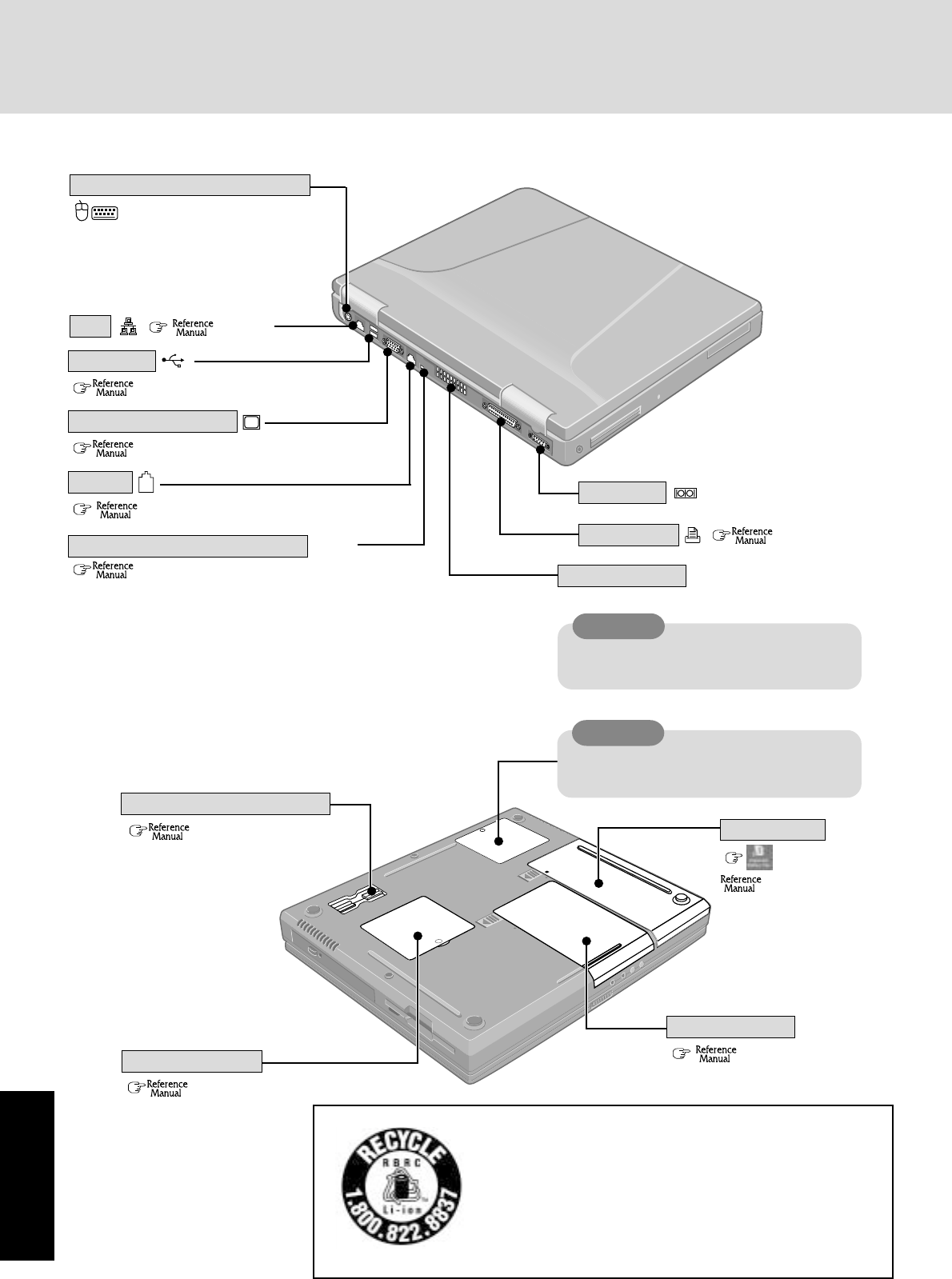
34
Appendix
( “Printer”)
External Keyboard/Mouse Port
USB Ports
( “USB Devices”)
These holes allow heat to exit.
CAUTION
Do not block or place the computer in a lo-
cation that may prevent proper ventilation.
This cover is not to be opened by anyone
except authorized service personnel.
CAUTION
RAM Module Slot
( “RAM Module”)
( “Port Replicator”)
Expansion Bus Connector
Battery Pack
( “LAN”)
( on the desktop,
“Battery Power”)
Hard Disk Drive
( “Hard Disk Drive”)
A lithium ion battery that is recyclable powers the product you
have purchased. Please call 1-800-8-BATTERY for information
on how to recycle this battery.
L’appareil que vous vous êtes procuré est alimenté par une batterie
au lithium-ion. Pour des renseignements sur le recyclage de la
batterie, veuillez composer le 1-800-8-BATTERY.
LAN
( “Modem”)
Names and Functions of Parts
( “IEEE 1394 Devices”)
IEEE 1394 Interface Connector
Modem
External Display Port
( “External Display”)
1394
Serial Port
Parallel Port
Ventilation Hole
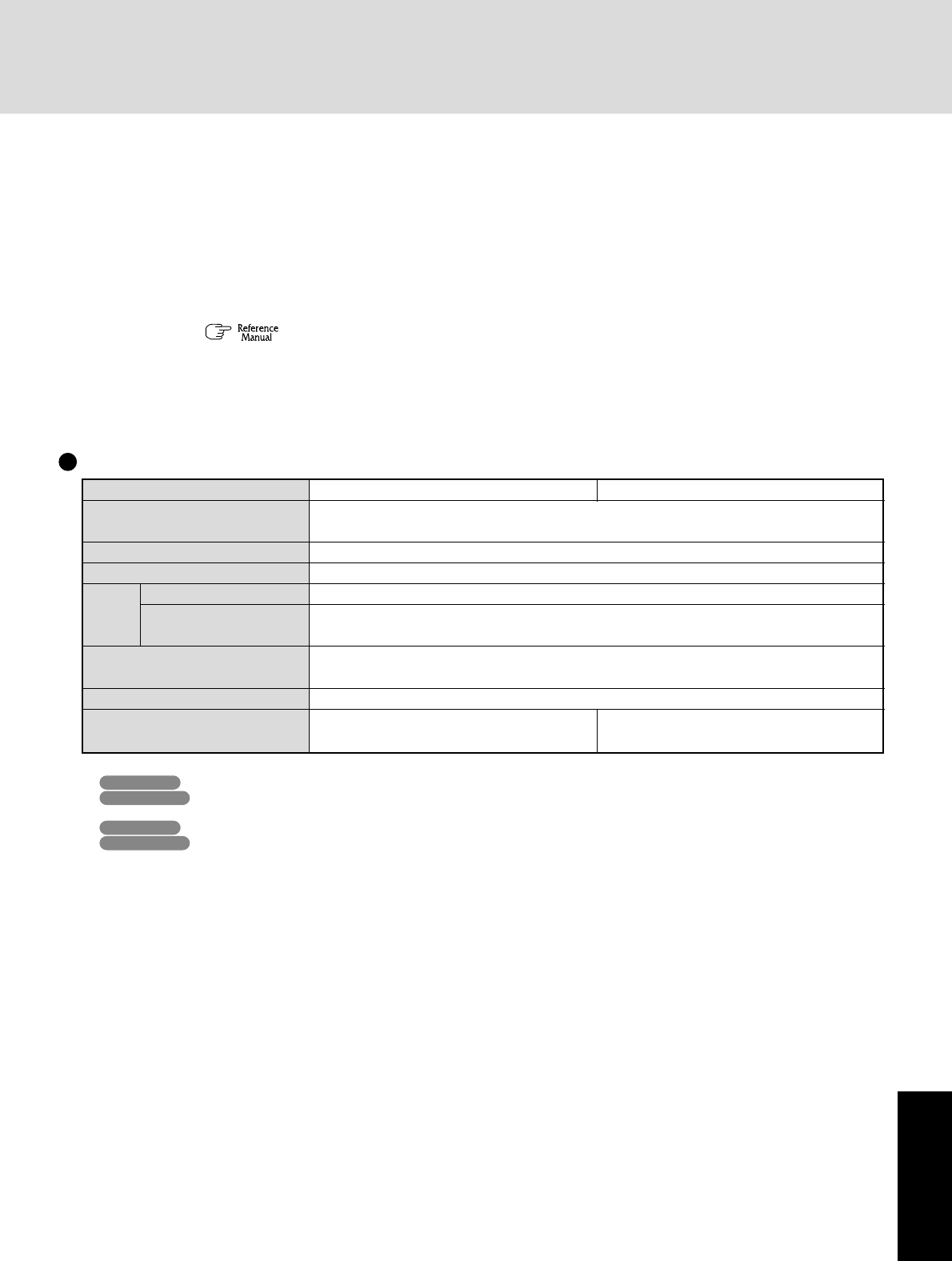
35
Appendix
Specifications
Main Specifications
*1A 16 M color display is achieved by using the dithering function.
Windows XP : 256 color depth and the resolution of 640x480 are not supported.
Windows 2000 : Setting 256 color depth or the resolution of 640 x 480 is not recommended.
*2Maximum resolution depends on the specifications of the external display.
Windows XP : 256 color depth and the resolution of 640x480 are not supported.
Windows 2000 : Setting 256 color depth or the resolution of 640 x 480 is not recommended.
*31GB = 109 bytes
This page provides the specifications for the basic model CF-50Y5KNUDM/CF-50Y5KNUKM. The model number will change
depending on the configuration of the unit, such as, CPU speed, memory size, HDD size, Operating System, LCD type, and
whether a CD-ROM drive, a DVD-ROM drive, a CD-R/RW drive, or a DVD-ROM&CD-R/RW drive is included or not.
To check the model number:
Check the bottom of the computer or the box the computer came in at the time of purchase.
CF-50Y5KNUDM CF-50Y5KNUKM
Mobile Intel
®
Pentium
®
4 Processor 1.9 GHz-M
L2 (Second) Cache Memory: 512 KB
256 MB (768 MB Max. )
32 MB
15.0 type (TFT)
256/65536/16M colors (640 x 480 dots/800 x 600 dots/1024x768 dots/1280 x 1024 dots/
1600 x 1200 dots)
256/65536/16M colors (640 x 480 dots/800 x 600 dots/1024x768 dots/1280 x 1024 dots/
1600 x 1200 dots/2048x1536 dots)*2
40 GB*3
Microsoft® Windows® 2000 professional Microsoft® Windows® XP professional
with Service Pack 2
Model No.
CPU
Memory (Expandable to)
Video Memory
LCD Type
Displayed Colors*1
External Display
Hard Disk Drive
Operating System
To check CPU speed, memory size and the hard disk drive (HDD) size:
Run the Setup Utility ( “Setup Utility”) and select [Information] menu.
Confirm the required information by checking the following items.
CPU speed: [CPU Speed]
Memory size: [System Memory]
Hard disk drive size: [Primary Master]
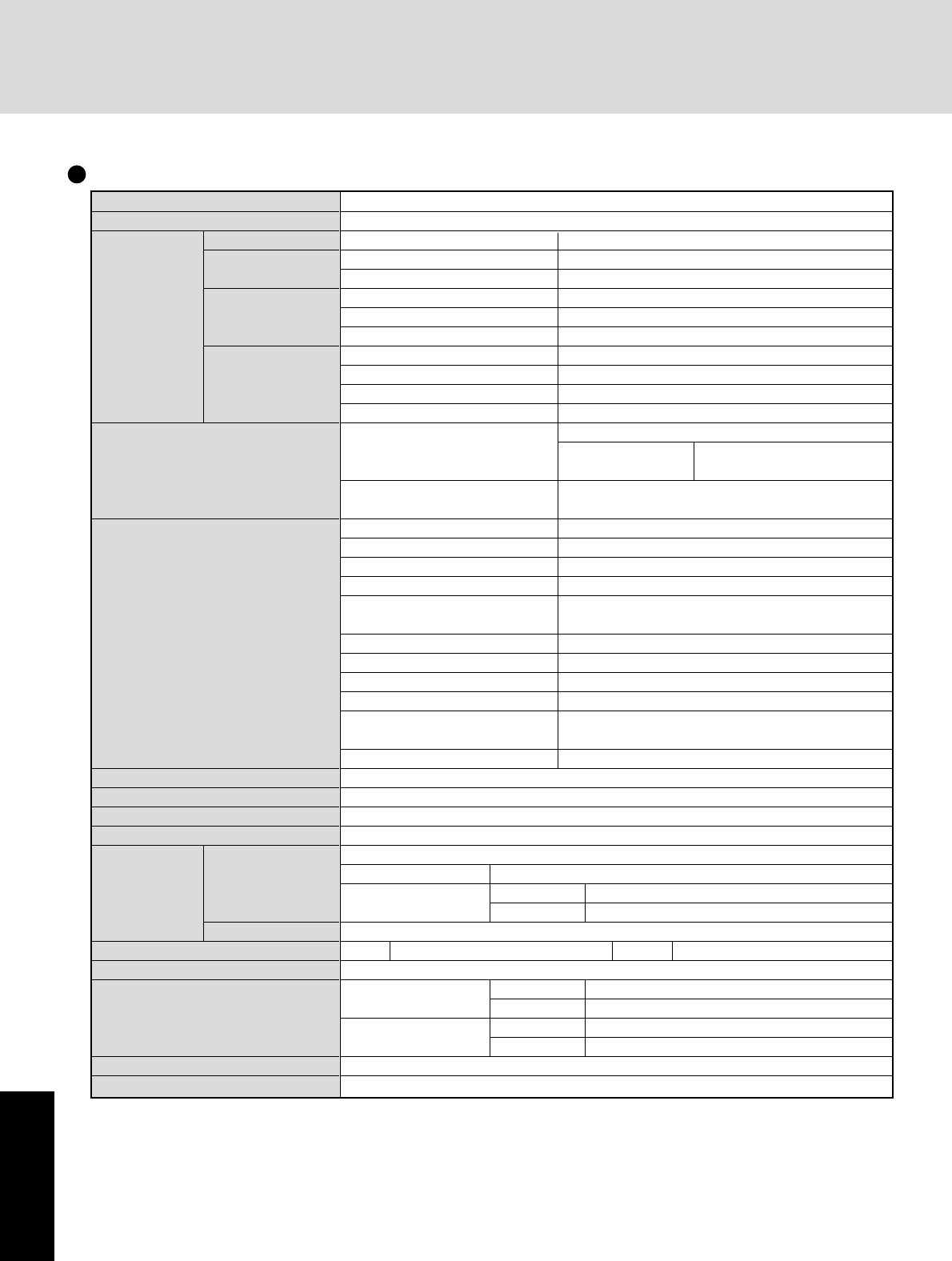
36
Appendix
*1If an unbalanced disc (e.g., a disc with which the balance has been displaced from the center) is inserted, the speed may become slower if
there are large vibrations while the disc is rotating.
*2Depending on the disc, the writing speed may become slower.
*3Only a RAM card designed for PC2100 can be added.
*4Use only a monaural condenser microphone.
*5Varies depending on the usage conditions.
*6The AC adaptor is compatible with power sources up to 240 V AC adaptor.
This computer is supplied with a 125 V AC compatible AC cord.
*7Approx. 0.9 W when the battery pack is fully charged (or not being charged) and the computer is OFF.
Approx. 1.5 W when the Wake up from LAN function has been enabled.
*8Rated power consumption.
Keyboard
Floppy Disk Drive
Optical Disc CD-ROM Drive*1
DVD-ROM Drive*1
CD-R/RW Drive
DVD-ROM &
CD-R/RW Drive
Slots
Interface
Pointing Device
Speaker
Utility Programs
Sound
Battery Battery Pack
Clock Battery
AC adaptor*6
Power Consumption*7
Environment
Physical Dimensions (W X H X D)
Weight
87 keys
720 KB/1.44 MB (two-mode)
CD-ROM read 24X speed (Max.)
CD-ROM read 24X speed (Max.)
DVD-ROM read 8X speed (Max.)
CD-ROM read*124X speed (Max.)
CD-R write*2
4X speed, 8X speed, 16X speed (Max.), 24X speed (Max.)
CD-RW write 4X speed, 8X speed, 10X speed
CD-ROM read*124X speed (Max.)
DVD-ROM read*18X speed (Max.)
CD-R write*2
4X speed, 8X speed, 16X speed (Max.), 24X speed (Max.)
CD-RW write 4X speed, 8X speed, 10X speed
PC Card Slots Two Type I or Type II, or one Type III
Allowable current 3.3 V: 400 mA, 5 V: 400 mA
(total for two slots)
RAM Module Slot*3200-pin, SO-DIMM, DDR-SDRAM,
PC2100 Compliant
Parallel Port Dsub 25-pin female
External Display Port Mini Dsub 15-pin female
Serial Port Dsub 9-pin male
Microphone Jack*4Miniature jack, 3.5 DIA
Headphone Jack Miniature jack, 3.5 DIA
Impedance 32 Ω, Output Power 4 mW x 2
External Keyboard/Mouse Port Mini DIN 6-pin female
Expansion Bus Connector Dedicated 100-pin female
USB Port 4-pin x 2
Modem RJ-11 Data: 56 kbps (V.90 & K56flex) FAX:14.4 kbps
LAN RJ-45 IEEE 802.3 10Base-T
IEEE 802.3u 100Base-TX
IEEE1394 Interface Connector 4-pin x 1
Touch Pad
Stereo Speaker
Setup Utility, DMI Viewer, Acrobat Reader, Hard disk data erase utility
WAVE and MIDI playback
Li-ion 11.1 V, 6.3 Ah
Operating Time*5Approx. 1.5 hours - 3.5 hours
Charging Time*5Power On Approx. 6 hours
Power Off Approx. 3.5 hours
Coin type lithium battery 3.0 V
Input 100 V - 240 V AC, 50 Hz/60 Hz Output 15.6 V DC, 5.0 A
Approx. 70 W*8 / Approx. 90 W (maximum when recharging in the ON state)
In use Temperature 5 °C to 35 °C {41 °F to 95 °F}
Humidity 30% to 80% RH (No condensation)
Not in use Temperature -20 °C to 60 °C {-4 °F to 140 °F}
Humidity 30% to 90% RH (No condensation)
325 mm X 47 mm X 278 mm {12.8 ” X 1.9 ” X 10.9 ”}
Approx. 3.5 kg {Approx. 7.7 lb.}
Other Specifications
Specifications

37
Appendix
LIMITED WARRANTY
PANASONIC PERSONAL COMPUTER AND PERIPHERALS LIMITED WARRANTY
Panasonic Computer Solution Company (referred to as “Panasonic”) will repair this product (other than software, which is covered by a separate
warranty) with new or rebuilt parts, free of charge in the U.S.A. for three (3) years from the date of original purchase in the event of a defect in materials
or workmanship. This warranty includes the AC adaptor but excludes the batteries and all other options and accessories which are covered for a
period of one (1) year from the date of purchase.
This warranty is extended solely to the original purchaser. A purchase receipt or other proof of date of original purchase will be required before
warranty performance is rendered.
This warranty only covers failures due to defects in materials or workmanship which occur during normal use. It does not cover damage which occurs
in shipment or failures which are caused by products not supplied by Panasonic, or failures which result from alteration, accident, misuse, introduction
of liquid or other foreign matter into the unit, abuse, neglect, installation, maladjustment of consumer controls, improper maintenance, modification or
service by anyone other than a Factory Service Center or authorized Panasonic Service Dealer, or damage that is attributable to acts of God.
Limits and Exclusions:
There are no other express warranties except as listed below.
PANASONIC SHALL NOT BE LIABLE FOR LOSS OF DATA OR OTHER INCIDENTAL OR CONSEQUENTIAL DAMAGES RESULTING FROM THE
USE OF THIS PRODUCT, OR ARISING OUT OF ANY BREACH OF THIS WARRANTY. ALL EXPRESS AND IMPLIED WARRANTIES, INCLUDING
THE WARRANTIES OF MERCHANTABILITY AND FITNESS FOR A PARTICULAR PURPOSE ARE LIMITED TO THE APPLICABLE WARRANTY
PERIOD SET FORTH ABOVE. Some states do not allow the exclusion or limitation of incidental or consequential damages, or limitations on how long
an implied warranty lasts, so the above limitations or exclusions may not apply to you.
This limited warranty gives you specific legal rights, and you may also have other rights which vary from state to state. If a problem with your product
develops during or after the warranty period, you may contact our representatives at 1-800-LAPTOP5. If the problem is not handled to your satisfac-
tion, then write to the Consumer Affairs Division at the address indicated below.
SOFTWARE LIMITED WARRANTY
Panasonic Computer Solution Company (referred to as “Panasonic”) warrants to you only that the disk(s) or other media on which the Programs are
furnished will be free from defects in materials and workmanship under normal use for a period of sixty (60) days from the date of delivery thereof to
you, as evidenced by your purchase receipt.
This is the only warranty Panasonic makes to you. Panasonic does not warrant that the functions contained in the Programs will meet your require-
ments or that the operation of the Programs will be uninterrupted or error free.
Panasonic’s entire liability, and your exclusive remedy under this warranty shall be limited to the replacement, in the United States, of any defective
disk or other media which is returned to Panasonic’s Authorized Service Center, together with a copy of the purchase receipt, within the aforesaid
warranty period.
Anything in the foregoing to the contrary notwithstanding, Panasonic shall have no obligation for any defects in the disk(s) or other media on which the
Programs are furnished resulting from your storage thereof, or for defects that have been caused by operation of the disk(s) or other media otherwise
than on the Product or in environmental conditions other than those specified by Panasonic by alteration, accident, misuse, abuse, neglect, mishan-
dling, misapplication, installation, maladjustment of consumer controls, improper maintenance, modification of damage that is attributable to acts of
God. In addition, Panasonic shall have no obligation for any defects in the disk(s) or other media if you have modified, or attempted to modify any
Program.
DURATION OF IMPLIED WARRANTIES, IF ANY, IS LIMITED TO SIXTY (60) DAYS.
PANASONIC ASSUMES NO RISK OF AND SHALL NOT IN ANY CASE BE LIABLE FOR ANY DAMAGES, INCLUDING, WITHOUT LIMITATION,
ANY SPECIAL, INCIDENTAL, CONSEQUENTIAL, OR PUNITIVE DAMAGES ARISING FROM BREACH OF WARRANTY OR CONTRACT, NEGLI-
GENCE OR ANY OTHER LEGAL THEORY, INCLUDING, WITHOUT LIMITATION LOSS OF GOODWILL, PROFITS OR REVENUE, LOSS OF USE
OF THE PROGRAMS OR PRODUCTS OR ANY ASSOCIATED EQUIPMENT, COST OF CAPITAL, COST OF ANY SUBSTITUTE EQUIPMENT,
FACILITIES, SERVICES, DOWNTIME COSTS, OR CLAIMS OF ANY PARTY DEALING WITH YOU FOR SUCH DAMAGES.
Some states do not allow the exclusion or limitation of incidental or consequential damages, or limitations on how long an implied warranty lasts, so
the above limitations or exclusions may not apply to you.
This limited warranty gives you specific legal rights, and you may also have other rights which vary from state to state.
This Limited Warranty will be governed by the laws the State of New York, without regard to its conflict-of-laws rules.
* * *
To obtain service or technical assistance within the continental U.S.A. and Alaska.
DIAL TOLL FREE: 1-800-LAPTOP5
Correspondence requesting product information should be sent to:
Panasonic Computer Solution Company
50 Meadowlands Parkway, Panazip 2F-5, Secaucus, NJ 07094
For U.S.A.

38
Appendix
PANASONIC COMPUTER AND PERIPHERALS LIMITED WARRANTY
Coverage – Panasonic Canada Inc. (“PCI”) warrants to you, the first end user customer, this computer product (excluding software media), when
purchased from PCI or from a PCI authorized reseller, to be free from defects in materials and workmanship under normal use, subject to the terms
set forth below, during the period of warranty coverage specified.
Remedy – In the event of a warranty claim, contact PCI’s representatives within the applicable warranty period, identifying the nature of the defect
claimed, at 1-800-668-8386 between 9:00 A.M. and 5:00 P.M., Eastern Time Zone, Mon. – Fri. (excluding holidays) for instructions on how to obtain
service. A purchase receipt or other proof of date of original purchase is required before warranty service is performed. Defective parts covered by
this Limited Warranty will be repaired or replaced with new or comparable rebuilt parts on an exchange basis. Warranty replacement or repair is
subject to the terms of this Limited Warranty for the balance of the original period of warranty coverage.
No Coverage – This Limited Warranty does not cover products purchased outside Canada. Neither does it cover damage to, failure of, or defects in
a product or accessory through mishandling, improper installation, abnormal use, misuse, neglect, accident, introduction of liquid or other foreign
matter into the product, alteration or servicing by anyone not authorized by PCI, or act of God.
IF YOU SHIP THE PRODUCT FOR WARRANTY SERVICE
Carefully pack the product, preferably in the original carton. Include details of defect claimed and proof of date of original purchase. No liability is
assumed for loss or damage to the product while in transit, if you chose your own transportation carrier.
SOFTWARE MEDIA LIMITED WARRANTY
Coverage – Panasonic Canada Inc. (“PCI”) warrants to you, the first end user customer, that the disk(s) or other media on which software program(s)
is/are supplied will be free from defects in materials and workmanship under normal use in Canada for a period of sixty (60) days from date of receipt
as evidenced by your purchase receipt for your Panasonic Computer product.
THIS IS THE ONLY WARRANTY THAT PCI MAKES RESPECTING THE SOFTWARE MEDIA. PCI does not warrant the software. Please refer to the
software licensor’s written warranty (accompanying the copy of the software) for any software warranty claim.
Claim Procedure – In the event of a defect in material or workmanship in the media during the sixty (60) day warranty period, and you return it,
transportation costs prepaid, to Panasonic Canada Inc., Computer Products Marketing, at the above address, within the warranty period, together
with a copy of your purchase receipt, and an explanation of the suspected defect, PCI will replace in Canada the defective disk(s) or other media.
Remedy – PCI’s entire liability, and your only remedy for any breach of this software media warranty is limited to replacement of the media only. It
does not cover any other damages, including, but not limited to, loss of use or profit loss, or special, indirect or consequential damages, or other
claims, whether or not of similar character.
No Coverage – This limited warranty does not apply if the disk(s) or other media has been used in other than a Panasonic product, or in environmen-
tal conditions other than those specified by PCI or the manufacturer, or if subjected to misuse, neglect, mishandling, modification or attempted
modification of the program, or if damaged by accident or act of God. PCI is not responsible for damage to or loss of any program, data or removable
storage media.
GENERAL
NO OTHER WARRANTIES – PCI DISCLAIMS ALL OTHER WARRANTIES, EITHER EXPRESS OR IMPLIED, INCLUDING, BUT NOT LIMITED TO,
IMPLIED WARRANTIES OF MERCHANTABILITY AND FITNESS FOR A PARTICULAR PURPOSE, WITH RESPECT TO THE SOFTWARE, SOFT-
WARE MEDIA, COMPUTER PRODUCT, OPTIONS AND ACCESSORIES.
NO LIABILITY FOR CONSEQUENTIAL DAMAGES – IN NO EVENT SHALL PCI BE LIABLE FOR ANY SPECIAL, INDIRECT OR CONSEQUEN-
TIAL DAMAGES ARISING FROM ANY BREACH OF THE LIMITED WARRANTIES SET OUT IN THIS DOCUMENT, OR FROM THE USE OF THE
COMPUTER PRODUCT, INCLUDING, WITHOUT LIMITATION, LOSS OF DATA, BUSINESS, PROFIT OR GOODWILL.
IN ANY EVENT, PCI’S MAXIMUM LIABILITY FOR ANY BREACH SHALL NOT EXCEED THE AMOUNT ACTUALLY PAID BY YOU FOR THE
COMPUTER PRODUCT.
NO ACTION, REGARDLESS OF ITS BASIS, MAY BE BEGUN AGAINST PCI MORE THAN TWO (2) YEARS AFTER THE CAUSE OF ACTION
AROSE.
Statutory Warranties – Some jurisdictions do not allow these limitations or exclusions, so they may not apply to you.
Scope of Coverage
Whole Product (except Batteries), AC adaptor and CD-ROM
(if factory installed)
Batteries, CD-ROM (unless factory installed), Port Replicator,
Extra Memory Modules and all other Peripherals, Options and
Accessories
Period of Coverage
Three (3) Years from Date of Original
End User Customer Purchase
One (1) Year from Date of Original End
User Customer Purchase
Type of Failure Coverage
Defective Materials or Workmanship
Defective Materials or Workmanship
For Canada
LIMITED WARRANTY

39
Appendix
Memo

Outline of the International ENERGY STAR® Office Equipment Program
The international ENERGY STAR® Office Equipment Program is an international program
that promotes energy saving through the use of computers and other office equipment.
The program backs the development and dissemination of products with functions that
effectively reduce energy consumption. It is an open system in which business proprietors
can participate voluntarily. The targeted products are office equipment such as computers,
displays, printers, facsimiles, and copiers. Their standards and logos are uniform among
participating nations.
As an ENERGY STAR® Partner, Matsushita Electric Industrial Co., Ltd. has
determined that this product meets the ENERGY STAR® guidelines for energy
efficiency.
Panasonic Computer Solution Company
50 Meadowlands Parkway, Panazip 2F-5,
Secaucus, NJ 07094
Panasonic Canada Inc.
5770 Ambler Drive Mississauga,
Ontario L4W 2T3
© 2002 Matsushita Electric Industrial Co., Ltd. All Rights Reserved.
Printed in Taiwan
TA0802-0
DFQX5338ZAT